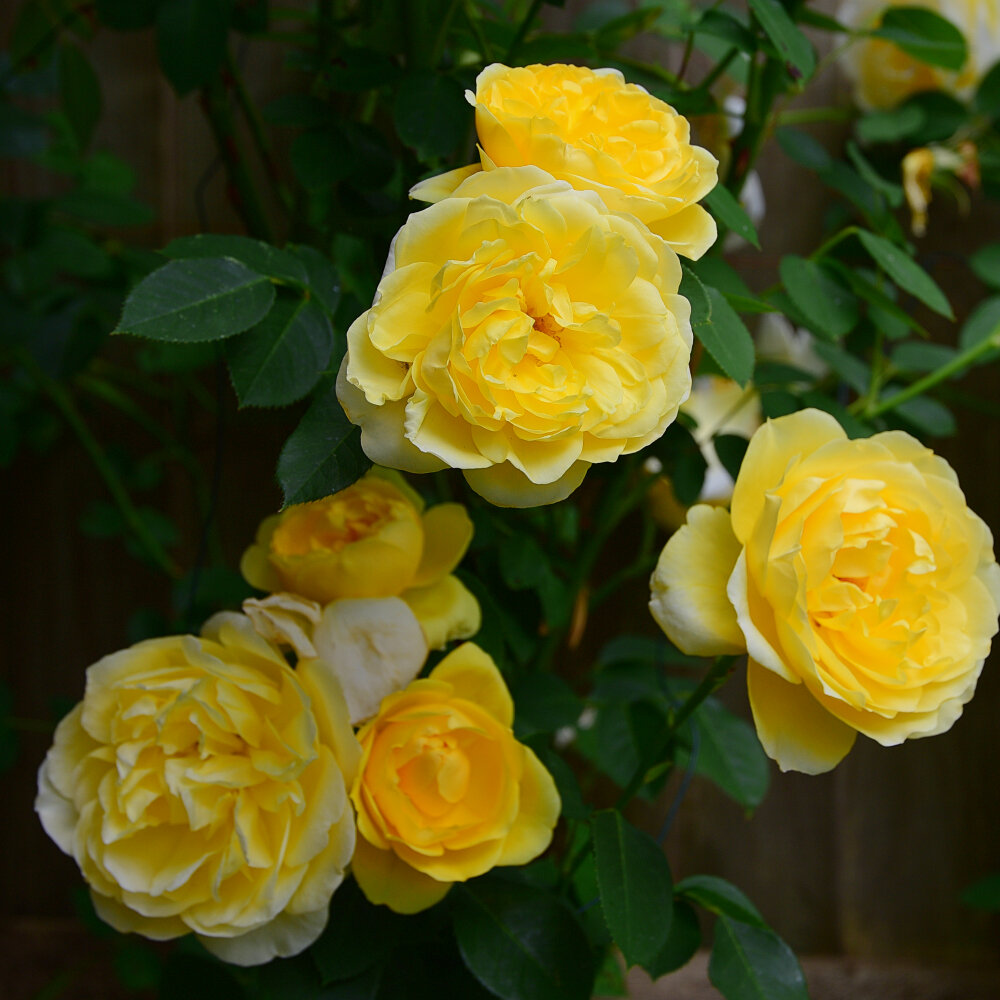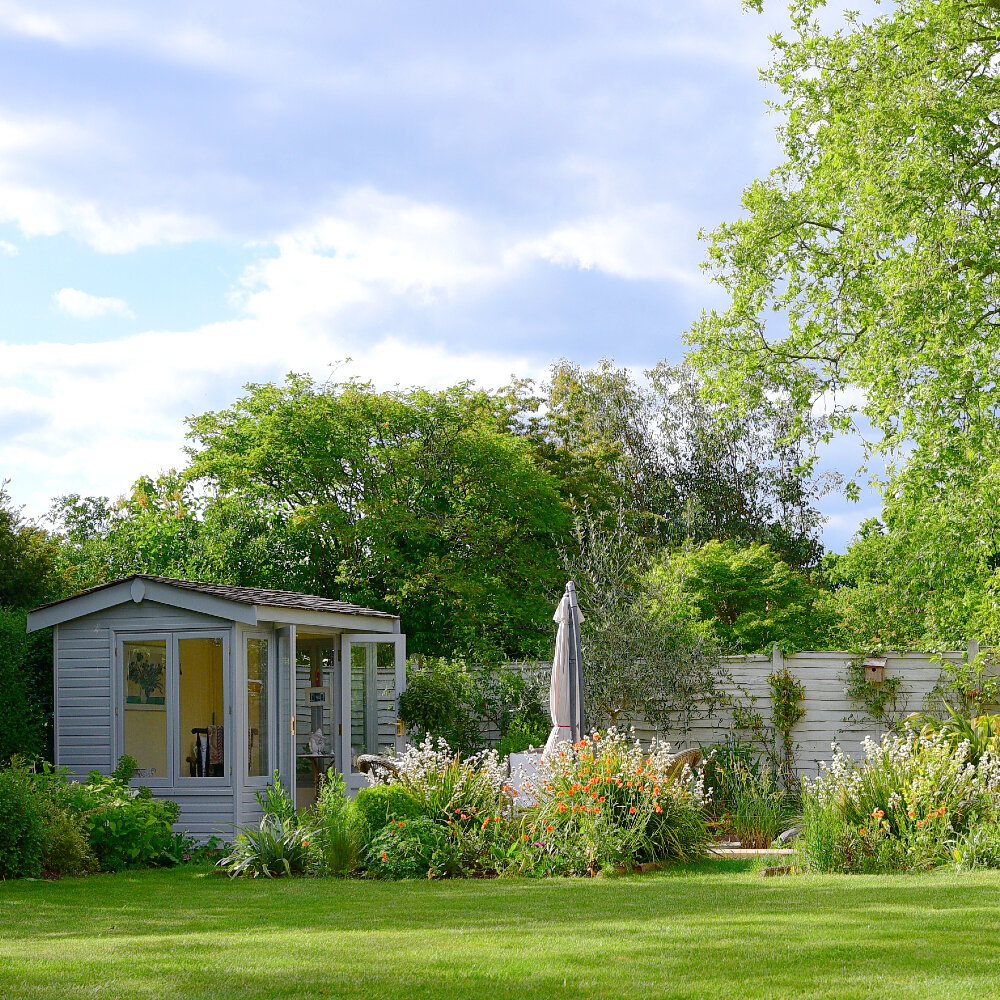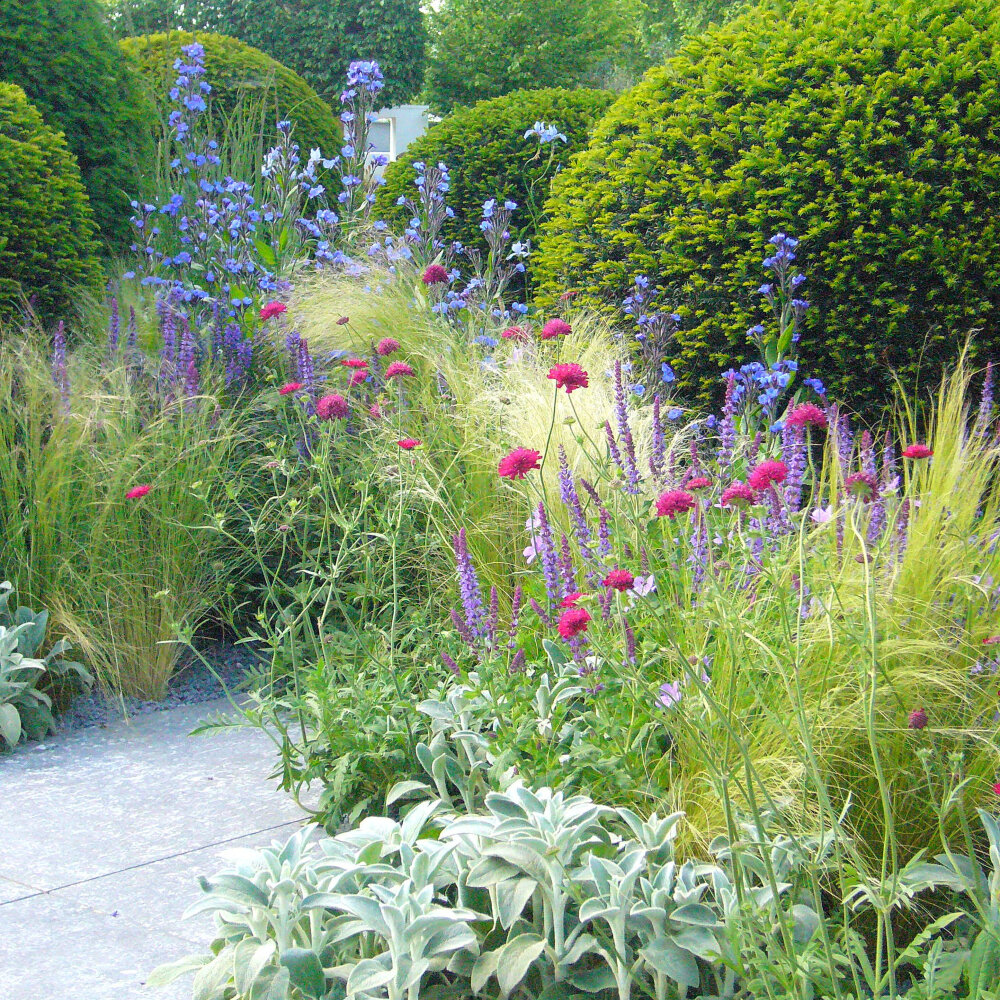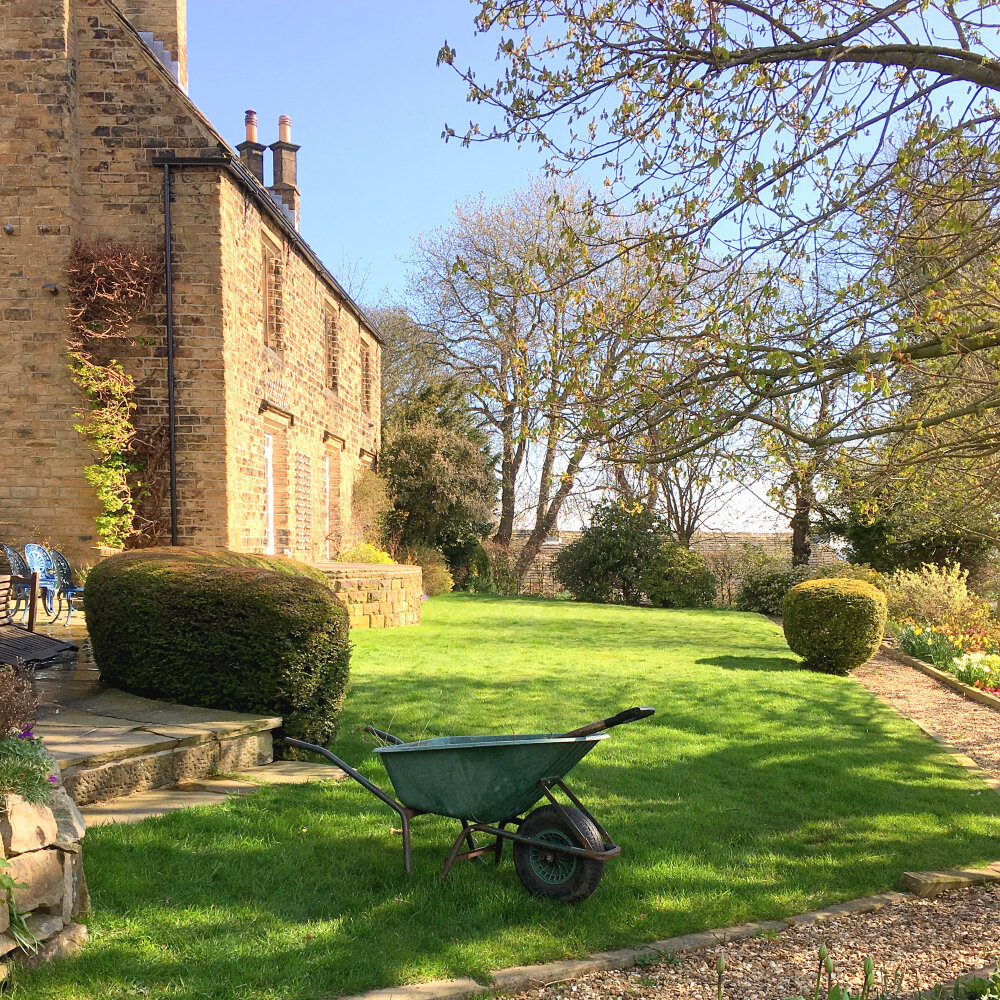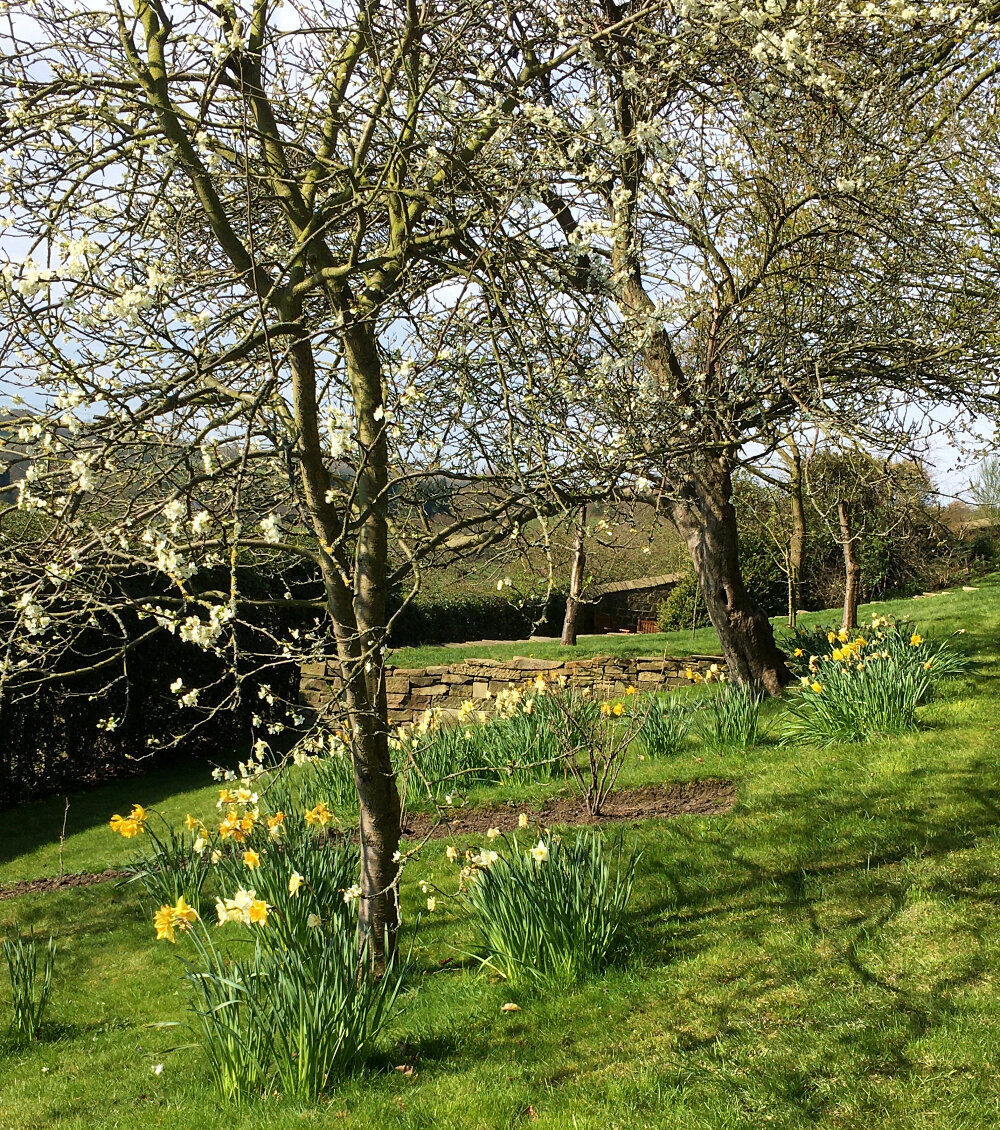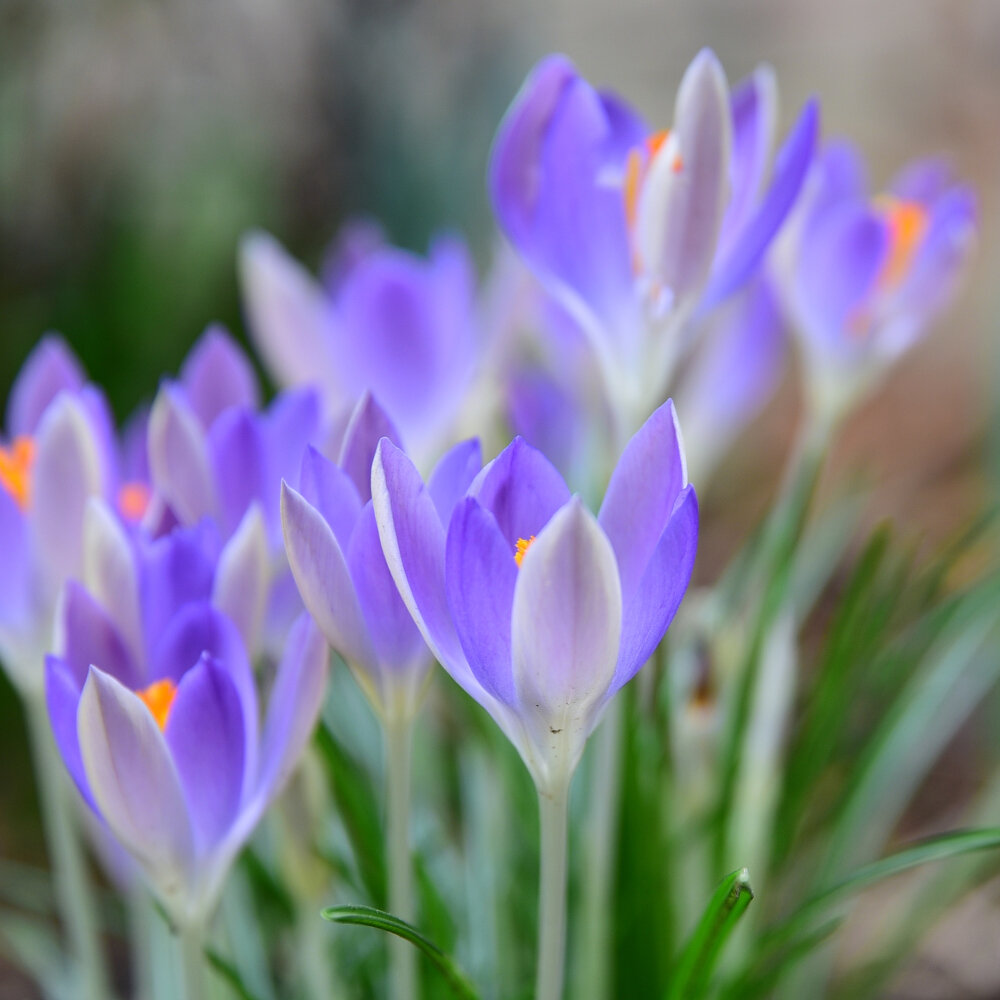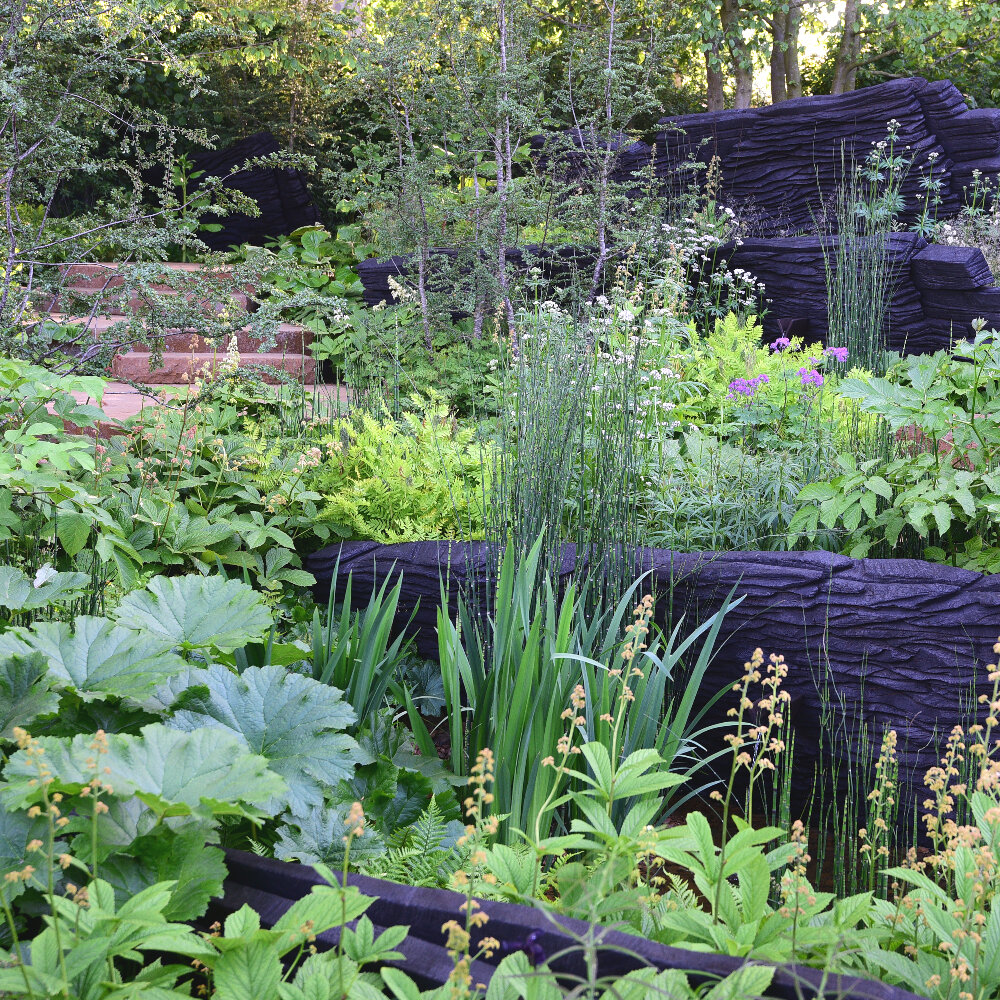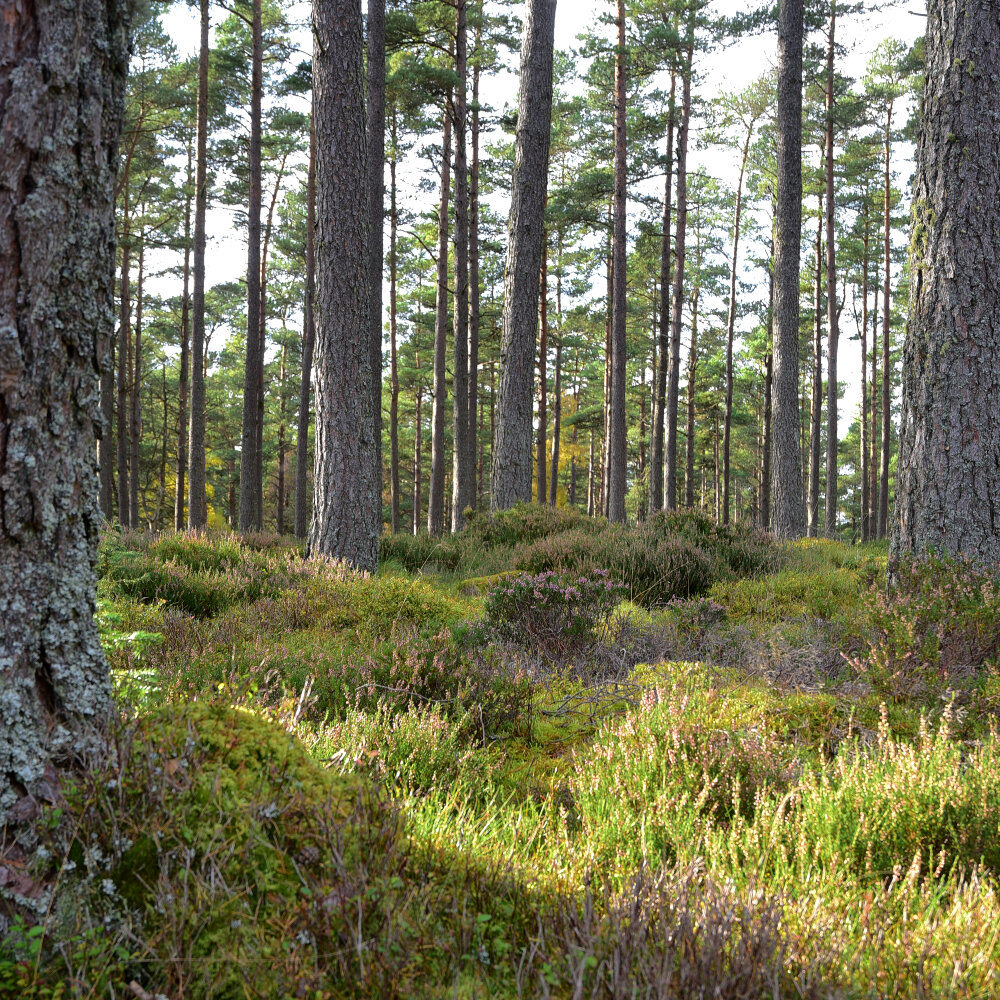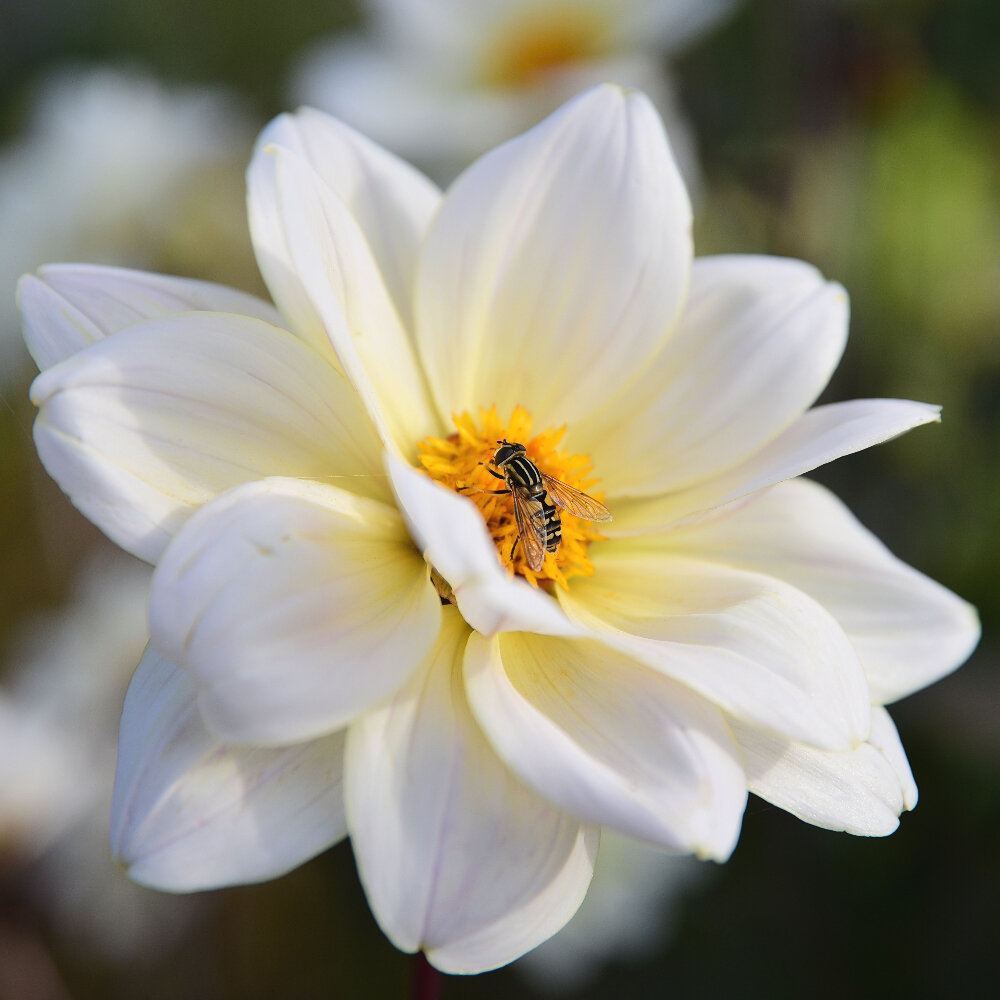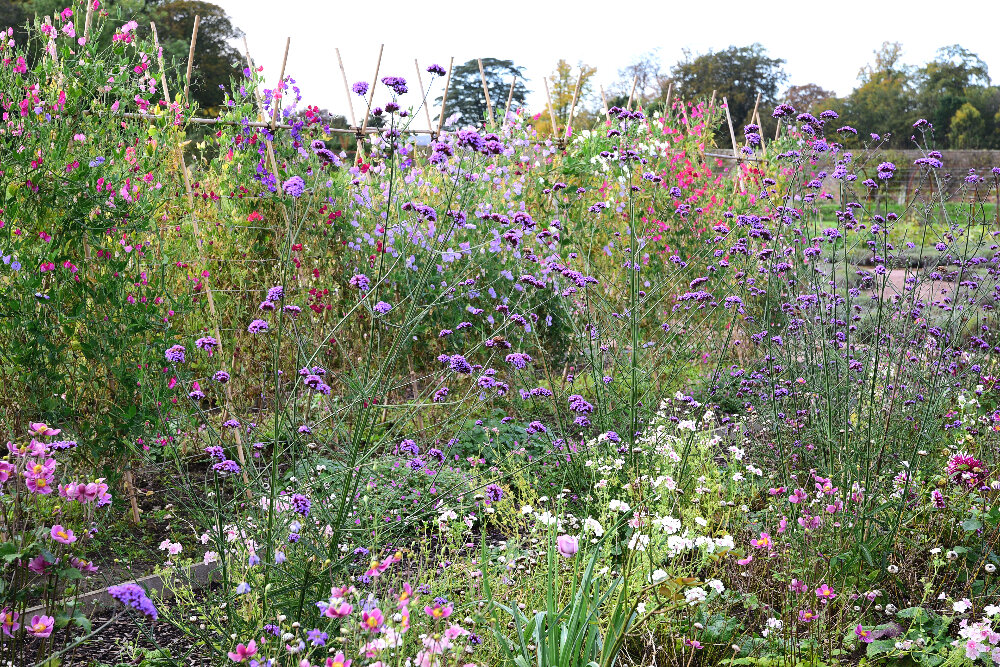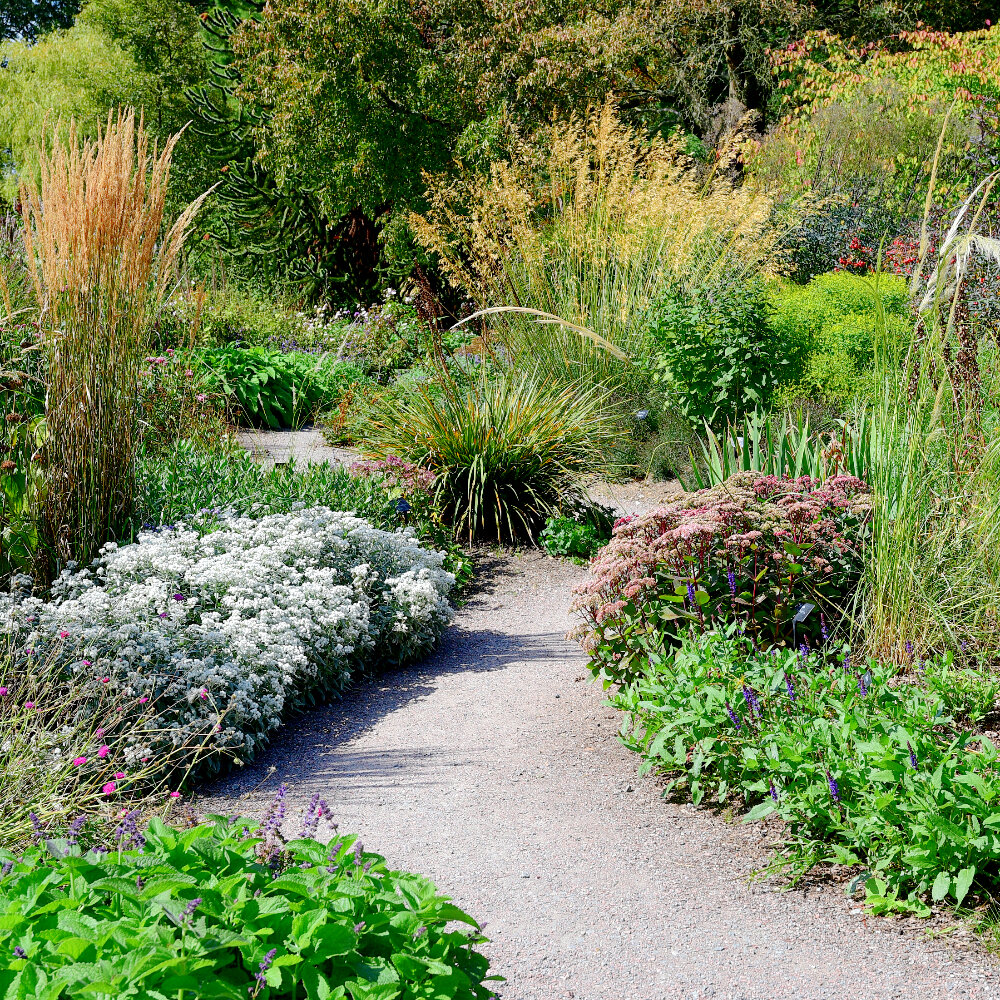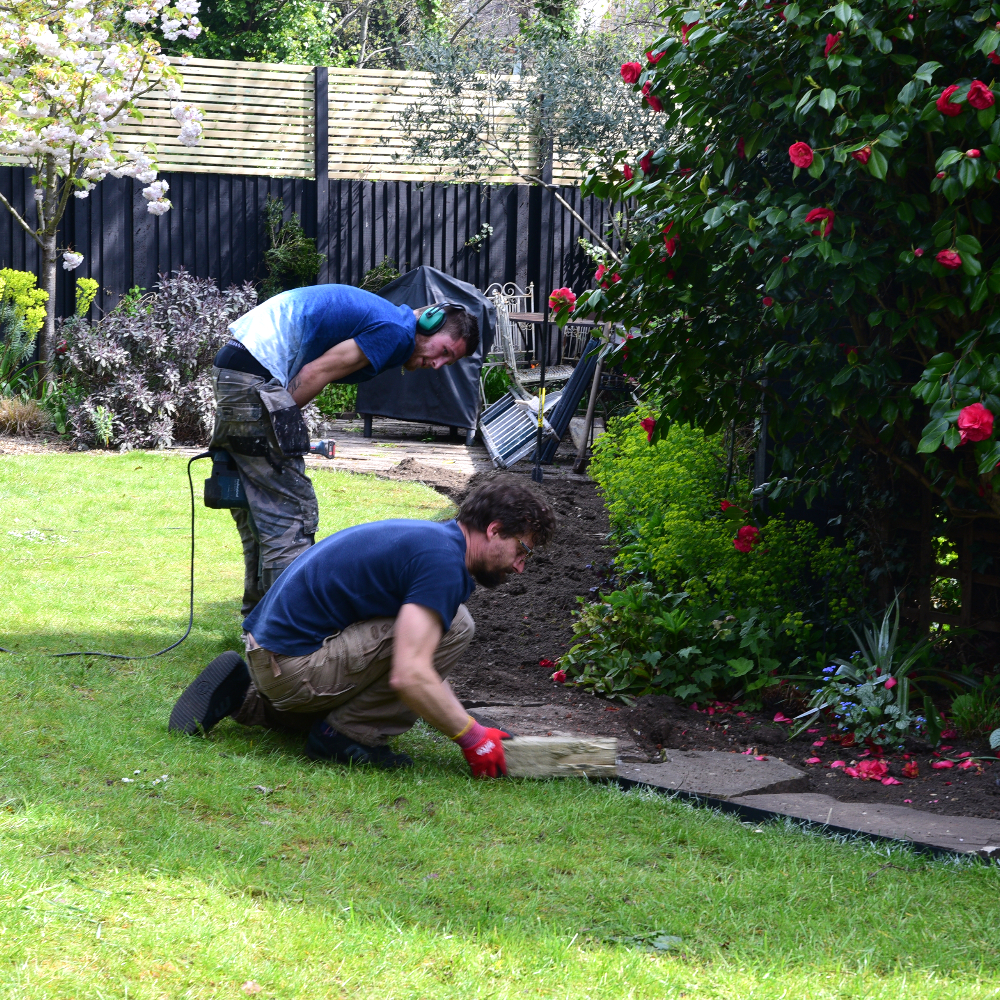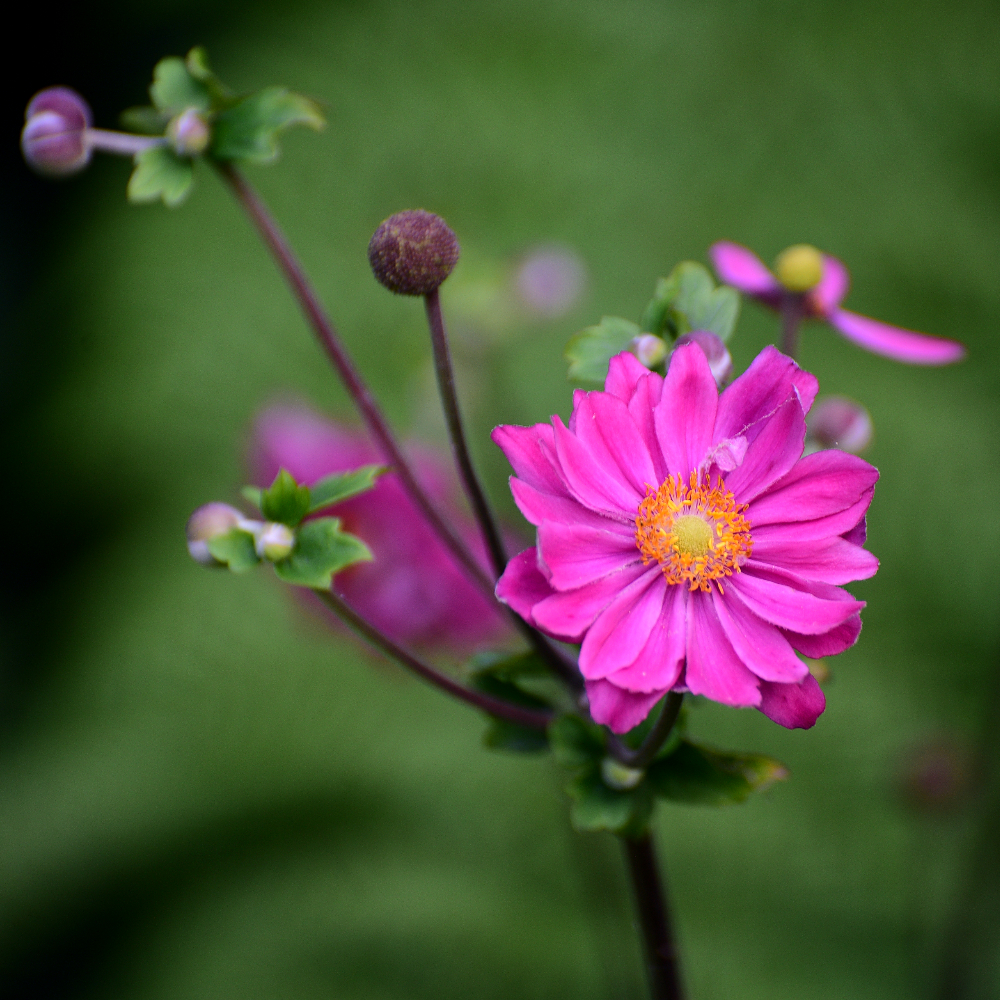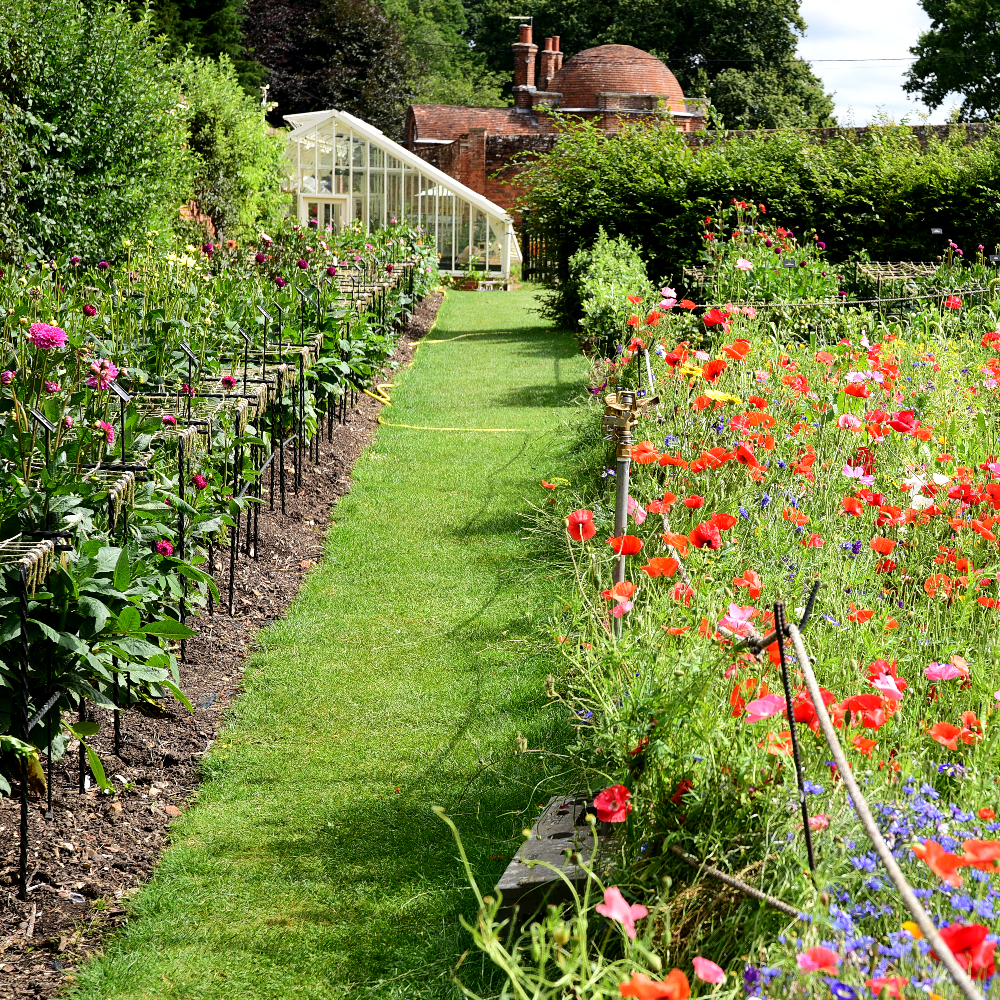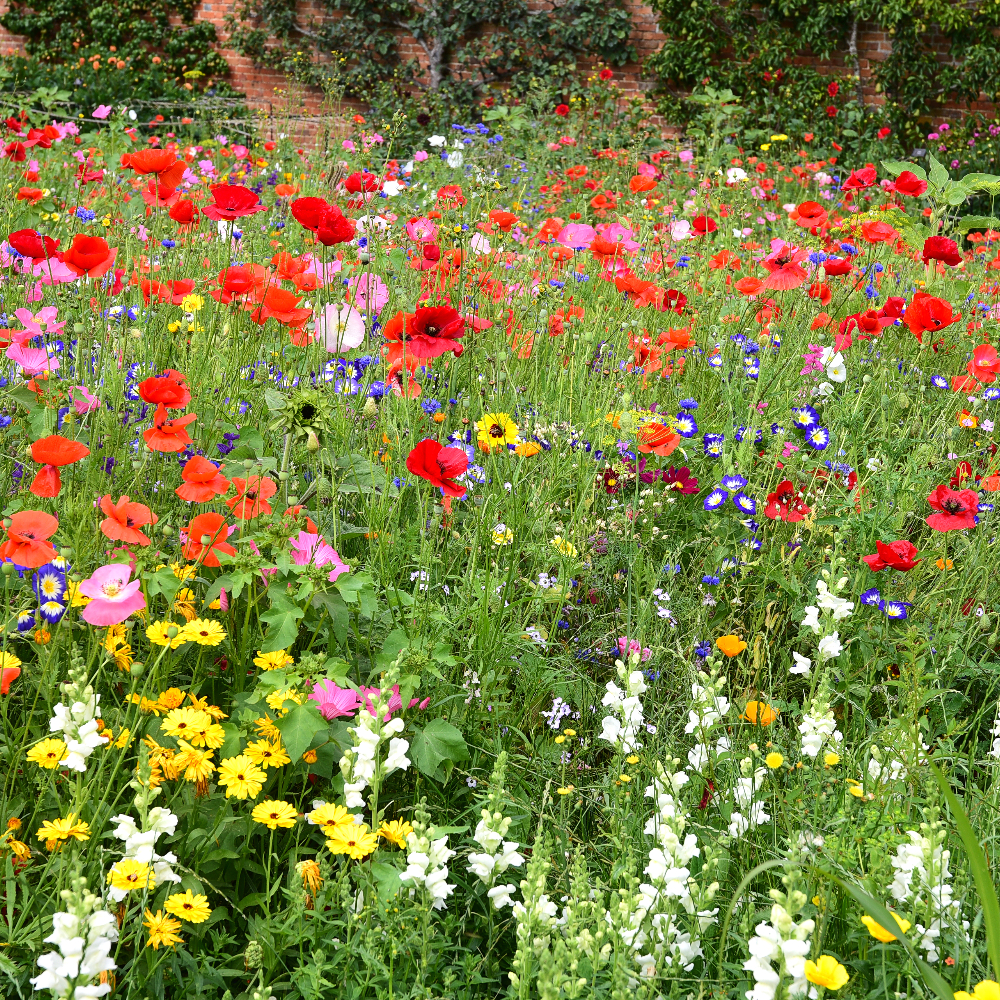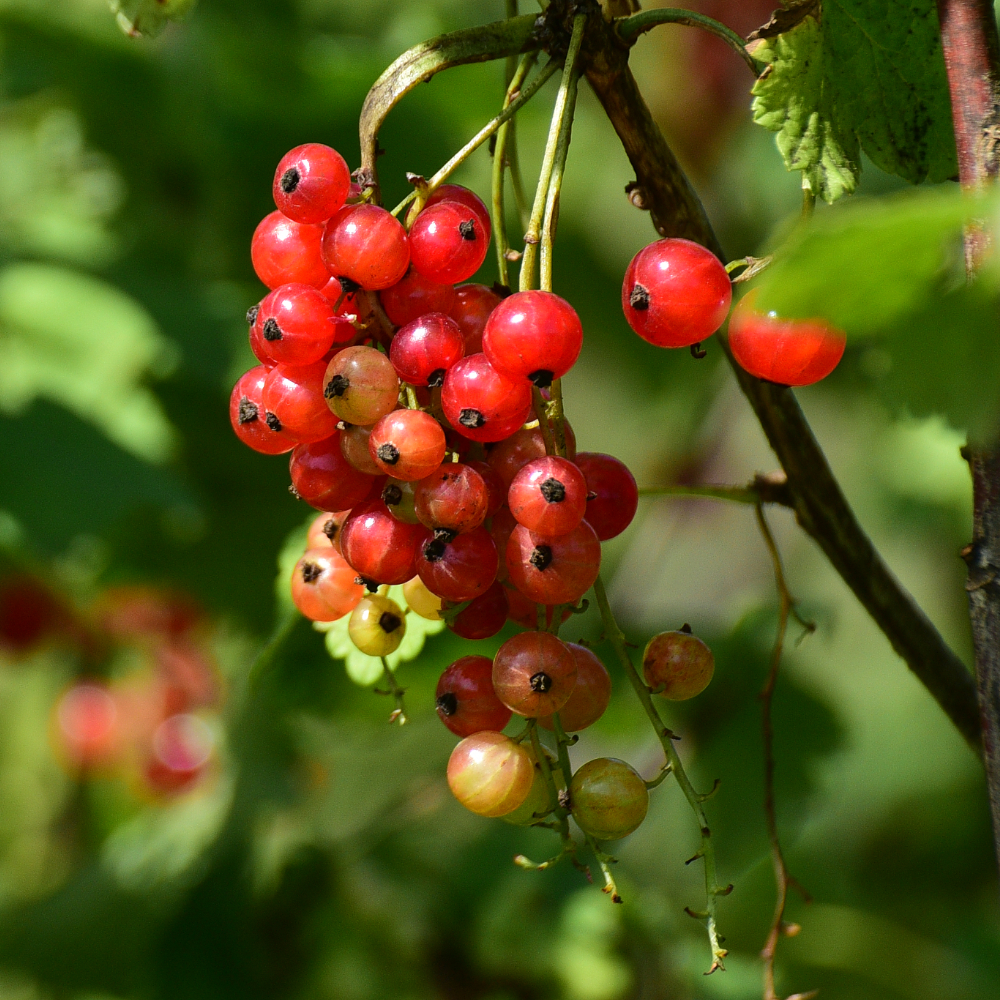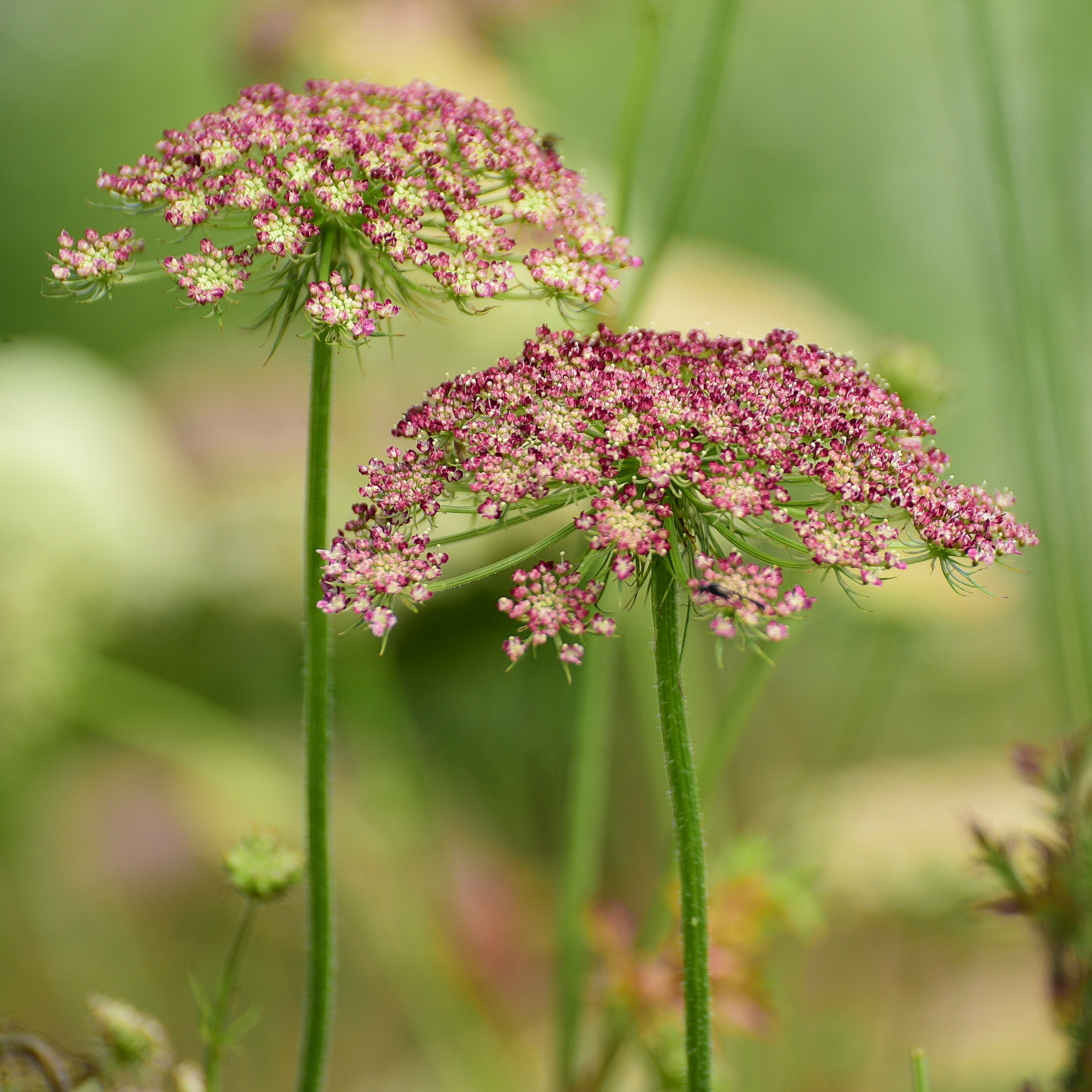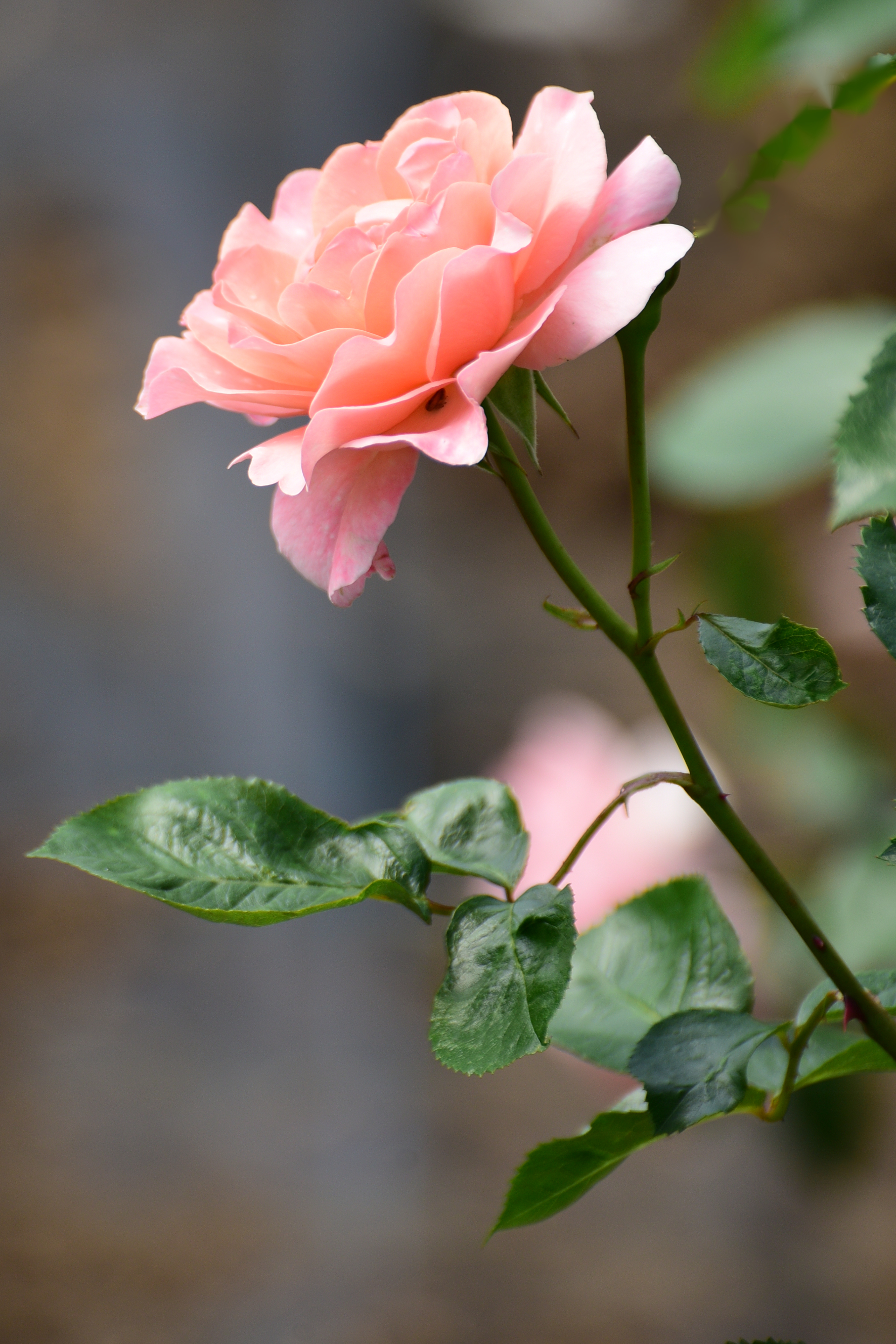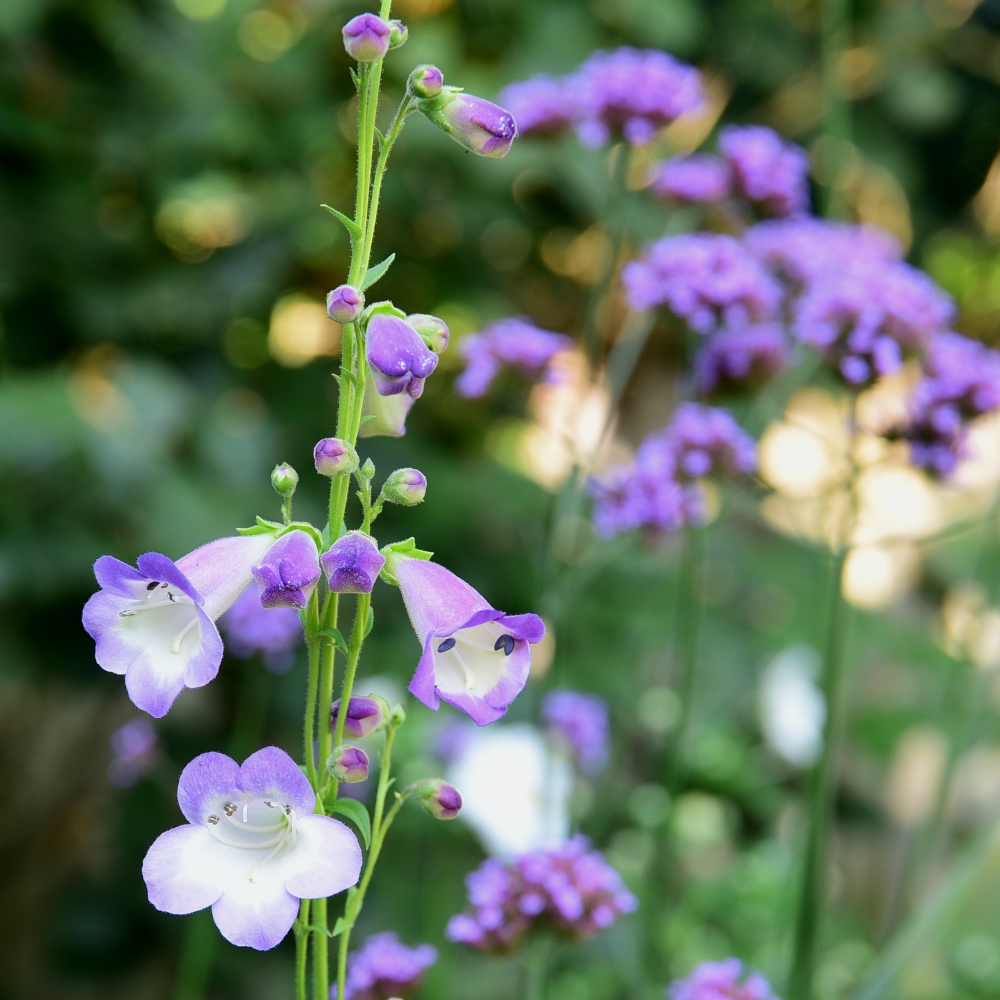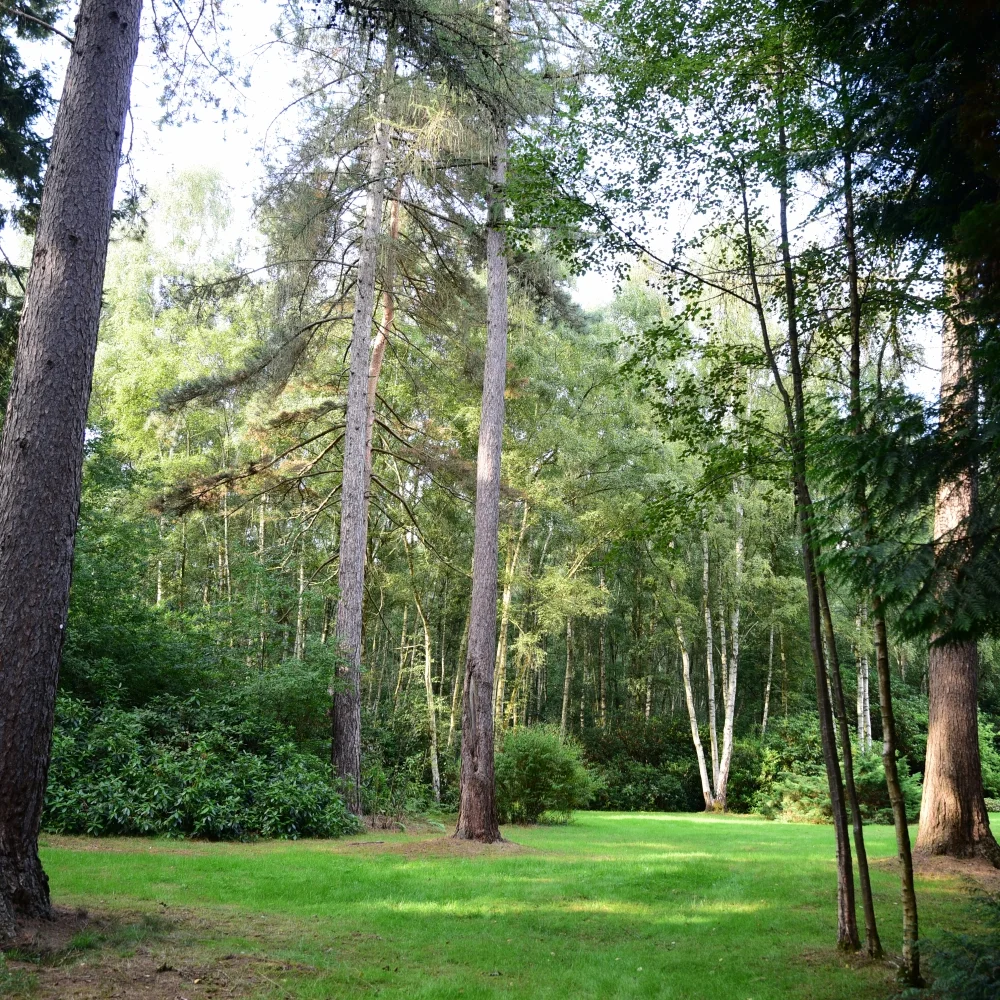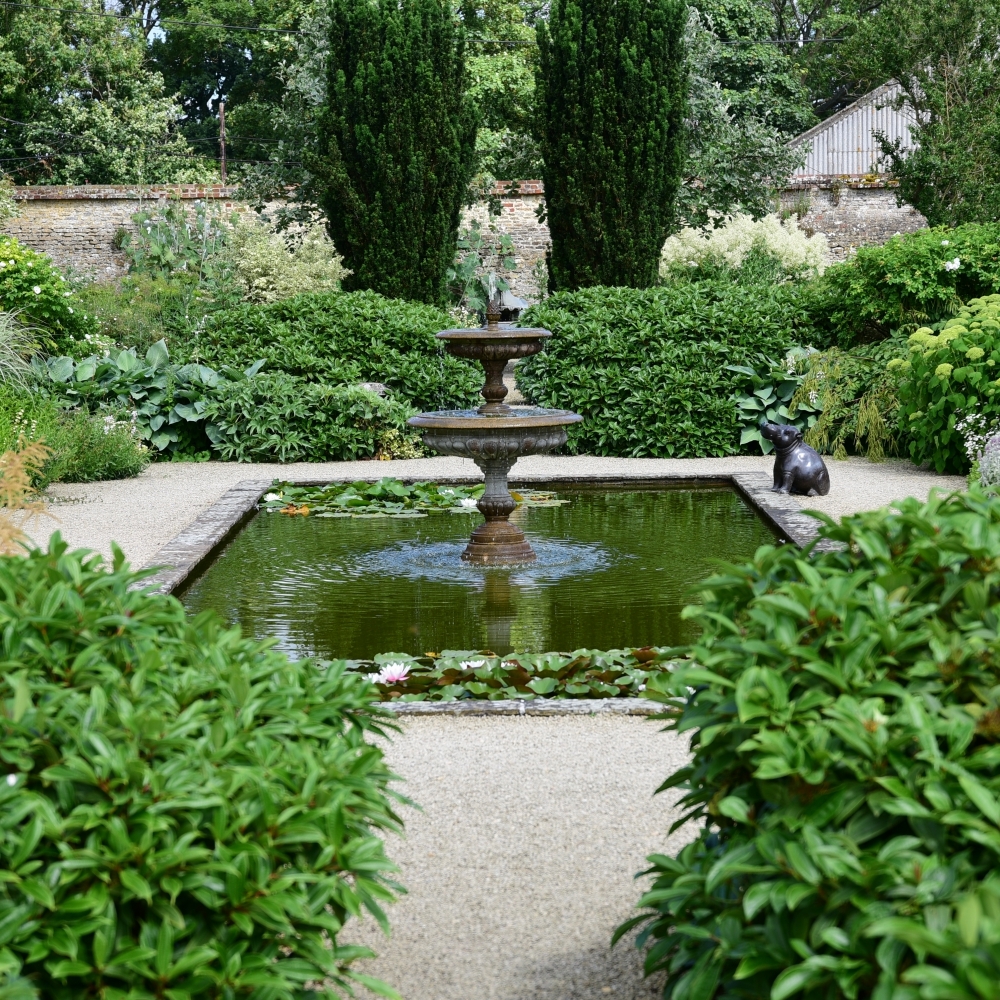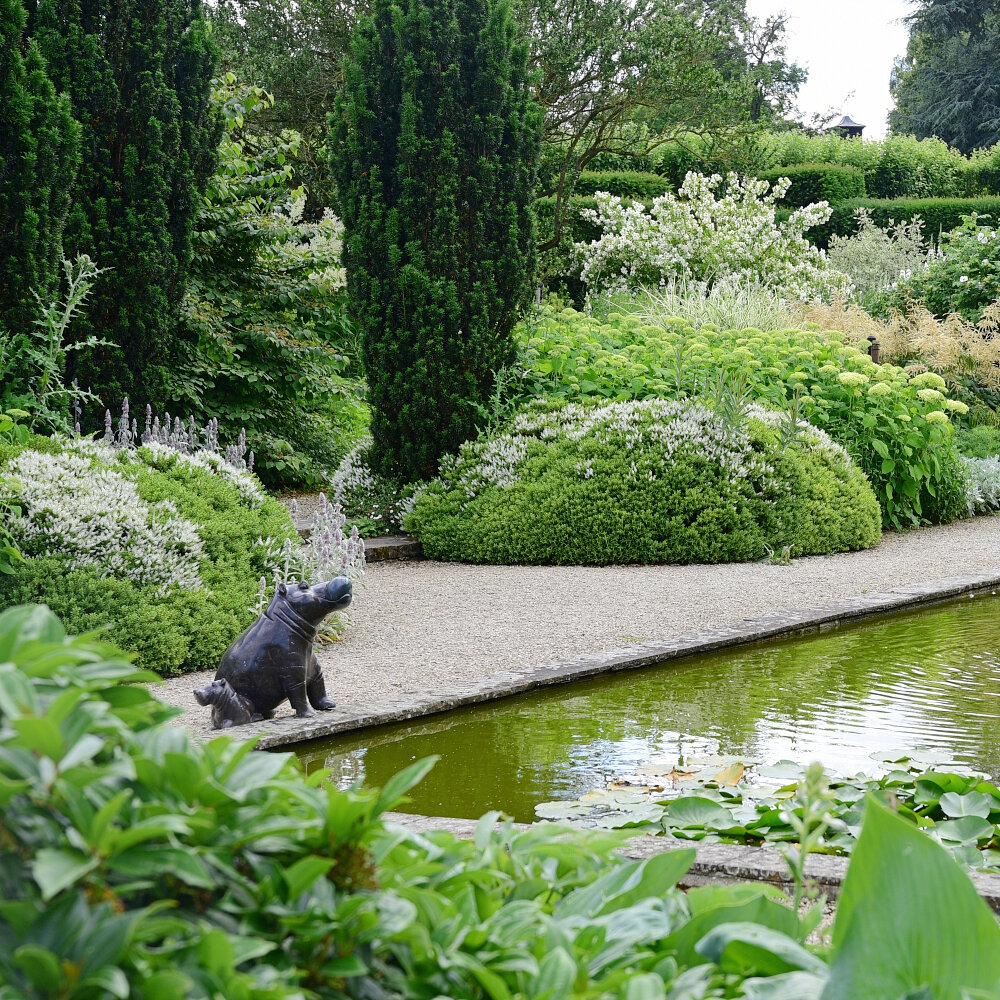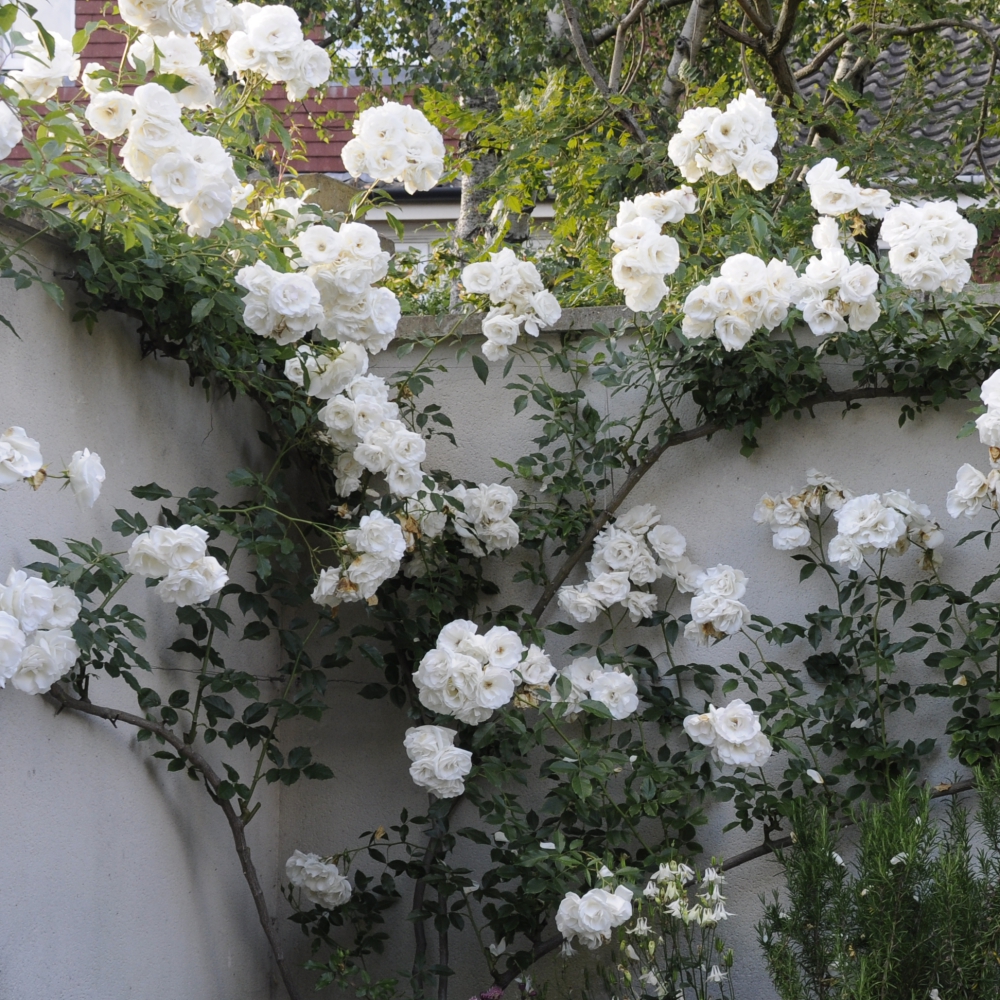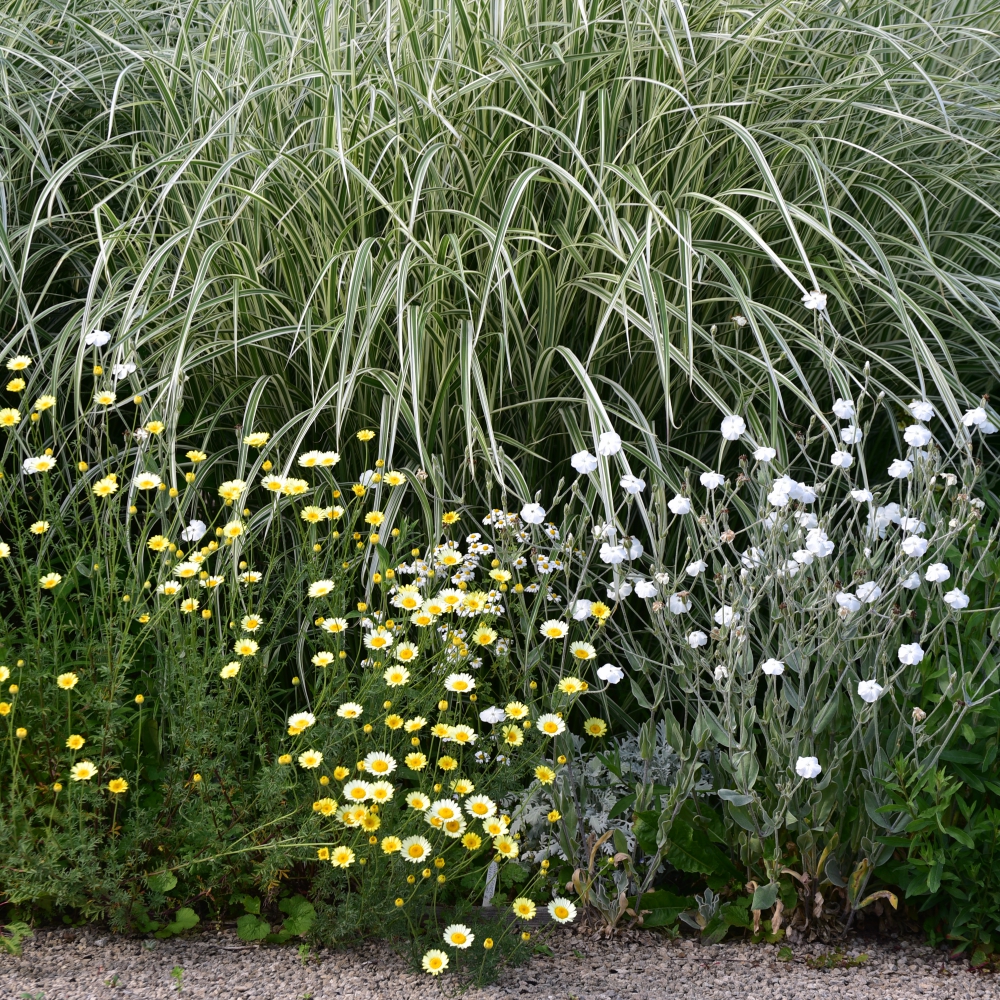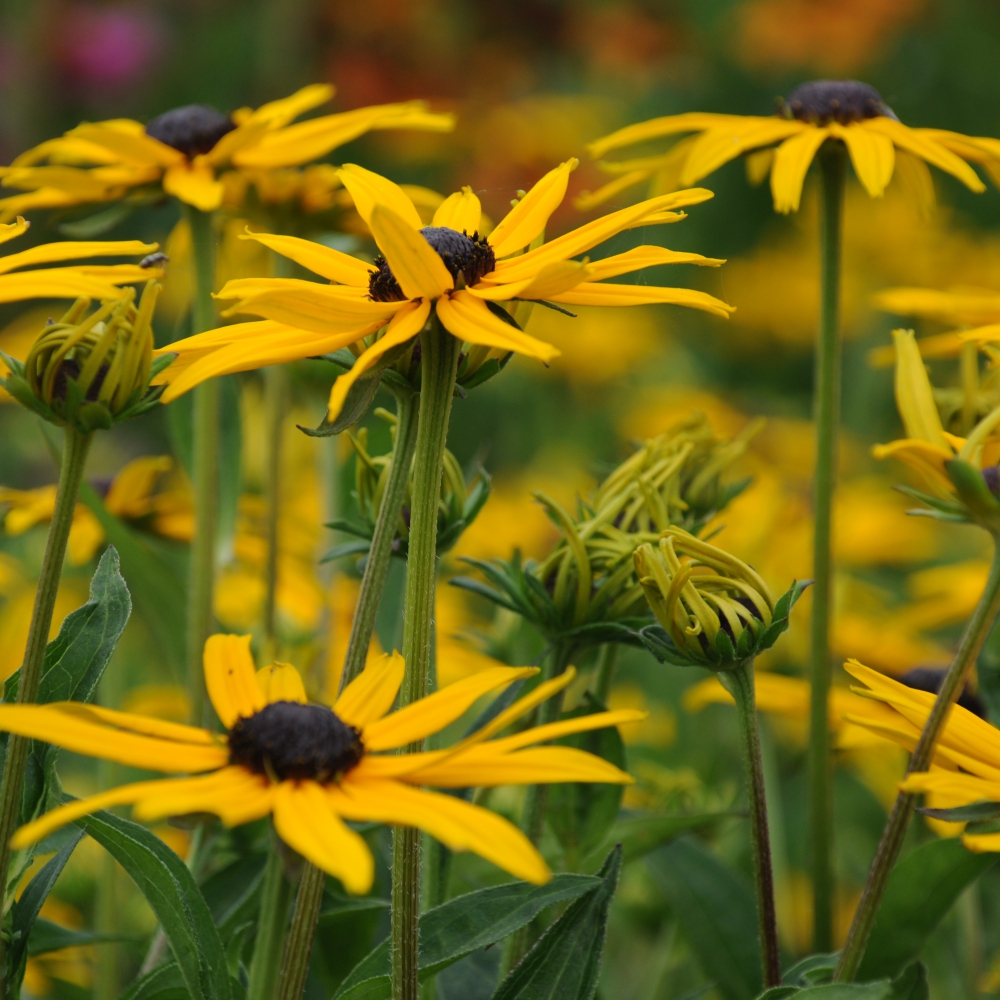Readers Gardens June 2020
The partial lift of lockdown measures hasn’t applied to public gardens. It’s just as well we’ve still got lots of readers’ gardens to visit.
Liz and Stephen
Starting in my neighbourhood with Liz and Stephen’s garden in one of the nicest roads in Wimbledon. You may remember this garden from last year when we replanted quite a bit of it.
One more growing season on and it’s really filled out. Liz has planted some more tulips and these ones, which I think are called Greenland, have lasted a really long time.
With an eye for a bargain Liz found these bright orange Geum borisii to complement the lighter-coloured Geum Totally Tangerine. Different tints of the same colour always work well together.
Some of the borders are edged with Erigeron karvinskianus. This hard working perennial flowers from May until November, it doesn’t need dead-heading and does a really good job of smothering weeds.
And at the end of the garden, starting to drape itself over the summerhouse, is Rosa Graham Thomas, surely one of the prettiest yellow roses.
Susanna and Richard
Across the other side of Wimbledon in the grounds of a charming house is a very different type of garden. When I met Susanna and Richard they were in the middle of a garden revamp, almost all the landscaping of which was done by Richard. This included rebuilding the cedar surround to a large koi carp pond, a bridge and a fab black garden room.
The wild flower meadow, under an amazingly productive quince tree, has been here for some time. In late May it’s just starting to get going.
I love the way the wild flowers are spilling over the paving, the shadows are really clear.
Susanna’s the one with the good taste, selecting a really nice palette of textured greens for the shady part of the garden. I’m looking forward to seeing this one when lockdown’s properly over.
Len and Barbara
To the country now and one of the first gardens I designed. There have been a few changes over the years. A couple of new borders have been added along with a smart summerhouse.
Len’s in charge of the lawn and raising a lot of plants, like these calendula, from seed. Barbara decides where they go.
The garden has matured in a really nice way and I like the intermingling of plants, like these Viburnum, Euphorbia and Lamium.
Barbara’s real pride and joy though are the large box balls, lovingly cared for over many years. Followed closely by an army of Alliums, these are Purple Sensation.
Readers' Gardens May 2020
As we’re still in lockdown the only gardens I can visit are those sent to me by loyal readers of my newsletter. It’s been a cracking month in terms of weather so everyone’s garden looks immaculate, even my own.
Alec and Sarah
Alec and Sarah garden in the grounds of a tall and elegant Victorian town house in a smart part of North London. The garden is only slightly larger than a postage stamp so every inch matters.
I designed this garden in 2016 and it was built and planted in 2017. It had a rough time with some builders shortly after that so I’ve never seen it in all its glory.
Looks like someone living here has got green fingers, it’s turned out pretty well!
Margaret
Margaret has a surprisingly large garden behind a smart villa in Wandsworth. Aside from lockdown Margaret works from home quite often. When we’re planning any changes in this garden the view from her desk is the most important one.
Margaret and I have been working together on this project for seven years. I did start off with a restrained palette but over the years I’ve been gradually beaten into submission with bright colours.
But I have resisted planting any Rhododendrons in the main part of the garden (so far….).
Susannah and Chris
To an exclusive address in the Surrey Hills now and the grounds of a cool and eclectic 18th century/1970s house.
When Susannah and Chris moved here there was a large swimming pool where this lawn is now. You can see how it used to look here.
This garden is proof that gardens only improve with age. Tiny shrubs and orphaned trees mature into good-looking specimens that give a garden back bone.
Sometimes though it’s the smallest details that give a lot of pleasure, like this Lily of the Valley growing beneath some steps.
Andrew and Hilary
And finally, on the other side of the country, we visit Andrew and Hilary’s garden in deepest Suffolk. I’ve never been here but I’d like to see it one day, especially the black swimming pool I’ve heard about.
Clearly there’s been some serious gardening going on here during lockdown - just look at that vegetable garden. That’s quite a eucalyptus tree as well.
Country gardens are so different to town gardens, there’s so much more space, room for quite different areas. I wonder where this path goes?
Back here maybe.
No end to lockdown in sight, what’s the hurry?
The greatest show on earth
The Chelsea Flower Show for 2020 was an early victim of Coronavirus, leaving a bit of a hole in many peoples’ diaries. The RHS, like lots of organisations, is adapting and going online with a virtual flower show. To whet your appetite I’ve been though all my photos from 13 years of shows to bring you my favourite garden from each year.
2007
This garden designed by Laurie Chetwood and Patrick Collins was a surprise gold medal winner, not least because it featured a giant mechanical flower. Apart from that I thought the planting was delightful, particularly this mix of huge yew topiary and softer perennial planting.
If you thought this garden was controversial, Best in Show went to the 600 Days garden based on life on Mars…
2008
This year my favourite did win Best in Show. It’s designed by Tom Stuart-Smith, one of my favourite designers.
I think it’s still one of all-time favourite gardens, and lucky Tom got to take these infinity water troughs home.
2009
I’ve picked another Best in Show winner this year as well. This was Swedish designer Ulf Nordfjell’s second garden at Chelsea.
I loved the different uses of the same material - big chunks of rough-hewn granite, smooth, honed paving and granite chippings. All juxtaposed with the wild-looking planting. I’ve based at least one planting scheme on a similar palette of plants and I love using silver-grey granite paving.
2010
Oh no, another Tom Stuart-Smith garden. I wouldn’t mind sitting here for the duration of lockdown.
Best in Show went to another Chelsea perennial, Andy Sturgeon, for his Cancer Research garden. He was described as a “young turk”, ahhh.
2011
An administrative blip on the photo filing front means I can’t bring you a good-quality photo of my favourite garden in 2011. But let me tell you, it was Cleve West’s Best in Show garden based on an excavation of a Roman ruin. Remember the toppled coloumns, that mustard-coloured wall and the flower of the year, Dianthus carthusianorum? I’m still using that plant.
2012
At last I’ve chosen an Andy Sturgeon design. Cleve West won Best in Show for the second year running but I think it should really have gone to Andy Sturgeon. That’s my theory anyway..
The sculpture of rusty circles is fab. Oh to have a design budget to run to that sort of frivolity.
2013
And now for something completely different. It takes an Australian designer, in this case Philip Johnson, to produce an amazing garden of waterfalls and native flora.
2013 was the centenary year for the Chelsea Flower Show, and it was notable for some of the spats between a couple of designers and the judges. Some mollification was made by the introduction of a Peoples’ Award, won this year by Chris Beardshaw, and a subsequent increase in the transparency of judging.
2014
My choice this year is a bit of a marmite garden. It did win Best in Show for Luciano Guibbelei but wasn’t universally popular.
I think it’s because the garden was relatively minimalist for Chelsea. Also, in another attempt to shake things up a bit the RHS started to encourage more younger designers to enter the show. Hugo Bugg, at 27, became the youngest designer to win a gold medal.
2015
In the last five or six years there has been a big move towards wilder-looking gardens like James Basson’s Provencal garden. Best in Show went to Dan Pearson’s evocation of part of Chatsworth’s trout stream.
This trend isn’t universally popular and prompts the question of what is a garden? Is an evocation of a wild landscape a garden design? I’ll leave that one with you…
2016
Bucking the trend in more ways than one was Jo Thompson’s Chelsea Barracks Garden. Best in Show went to Andy Sturgeon’s geology inspired design but Jo’s garden was a refreshing change.
Manicured to within an inch of it’s life it was all sleek lines and planting perfection. You could smell the roses from 20 yards away.
2017
My choice here is another James Basson garden, this time an evocation of a Maltese quarry. The research into the native flora was meticulous, and getting and growing the plants required painstaking attention to detail.
I love the blocks of stone and wildflowers but again it wasn’t everyone’s cup of tea.
2018
This another year where I think the judges got it wrong. Best in Show went to Chris Beardshaw (finally) but I thought his garden was poorly laid out for visitors to be able to see. My favourite was Sarah Price’s Mediterranean garden.
Perhaps it was too similar to James Basson’s garden the previous year, but I thought the planting was fantastic. Unusually for a show garden there were no chairs.
2019
And finally to 2019. Yet again it’s another Andy Sturgeon garden. It was a popular winner of Best In Show but who can forget Mark Gregory’s canal garden, winner of the Peoples’ Choice?
It’s going to be interesting to see how the RHS will produce a virtual Chelsea, particularly when it comes to the show gardens. In the absence of the real thing I’ll be checking it out. How about you?
Readers' gardens - April 2020
As I can’t get out and about and do my normal, if sporadic, review of gardens my mother suggested I feature some of my readers’ gardens. And quite a few have obliged with some photos. Apologies in advance for a bit of editing…
Helen’s garden
Helen gardens in the grounds of a south-facing London mid-terrace. The standout feature here is the beautiful multi-stemmed Acer at the back. Unfortunately neither of us knows the name.
The view from underneath is pretty impressive.
Helen (along with my dad of course) is one of my veg gurus, although she does have a strange prediliction for beans which I hate. She’s pretty good at bulbs in containers as well, these are Tulipa Queen of the Night, one of my favourites.
Rachel and Peter’s garden
Up to the far north of England now where it’s still winter really. Deep in the heart of the rhubarb triangle Rachel and Peter garden in the grounds of a magnificent rectory with great views.
You’ll have noticed it’s proper gardening up here - wheelbarrows, wellies, outside lavs, old Barbours and flatcaps are a must. But alas there’s no whippet on a bit of string.
On the plus side there’s room for a mini-orchard and dry-stone walling. The latter is put to good use to block up the vicar’s gate into the garden.
Desna and Rob’s garden
Back to London and a garden in the grounds of an Edwardian terrace. One can see immediately that this is a cool garden, not least because it was designed by yours truly.
It’s been a few years now and Desna and Rob have made it their own. Finally they got the steamer chair I’ve been nagging them about. You can see what the garden used to look like here https://www.arthurroadlandscapes.co.uk/designs#/balham-courtyard-garden/. Very good barbecues are to be had here, luckily Rob did not include the BBQ in the photo.
This is a garden that really comes into it’s own later in the summer when Desna’s amazing dahlias hit their stride. We may come back then…
Nicola’s garden
A few miles further south-west is Nicola’s garden, in the grounds of a nice Edwardian semi. I have to admit to a bit of cheating here, this is a garden I designed and also maintain so the photos are mine (perhaps I shouldn’t have said that).
We revamped the garden quite a bit last year and I planted a lot of new bulbs. You can read about the update here https://www.arthurroadlandscapes.co.uk/blog-/2019/8/14/breathing-new-life-into-a-teddington-garden
Somehow though a few rogue red and yellow ones have popped up to interrupt my purple and pink scheme. They’re safe for now but as soon as they’ve finished flowering…
These crocuses are nothing to do with me but every time I see them I think I should plant some more.
A big thankyou to everyone who volunteered for this article…. If you’d like your garden to be featured next time please send me some photos by 20 April.
Hunte's Gardens
One of my favourite things about Hunte’s Gardens is the entrance. It’s a bit like stepping out the back of the wardrobe into a tropical Narnia (minus the talking animals). The lady taking your entrance fee emerges from behind a large palm and then melts away again.
I’ve been here a few times now and never tire of it. The gardens are the work of Anthony Hunte, with the assistance of five workers. He started from scratch in a sink hole on an old sugar plantation in 1990.
Steps wind their way down the sides of the sink hole. There are a couple of way points on the descent with seating and water features. Once at the bottom you are struck by the height of the Royal Palms, they have reached a mature height of around 25m.
In classic garden design style, only parts of the garden can be seen at once. Lots of paths lead you on round corners to private seating areas, giving you plenty of opportunities to sit back and listen to the pianist playing in Anthony’s house above.
Where the sides of the sink hole are too steep to plant they are festooned with creepers like this bearded fig, Ficus citrifolia. This is the tree from which it is believed the name Barbados came from.
The range of plants which can be grown here make any northern hemisphere gardener green with envy. Whilst we can grow hibiscus in the UK, they can’t compete in terms of size and colour with those grown in the tropics.
The gardens are decorated with many different water features, in particular large bowls filled with water lilies and lotus flowers. Orchids are dotted around like jewels.
I’ve always found it’s best to come here early, mainly to avoid a deluge of cruise passengers. Not all of them can manage the stairs however.
If you do visit Barbados on a cruise just hop in a cab and come straight here, by-passing visits to other gardens.
And don’t be put off by any rain, it’s much easier to take good photos when there’s no bright sunshine to contend with. And anyway, the rain never lasts long.
Refreshments are available and include Anthony’s infamous rum punch. A few gewgaws can also be bought here.
Even if you could get there, like pretty much everywhere at the moment, Hunte’s Gardens is closed until further notice.
Hunte’s Gardens doesn’t have a website but you can find them on Facebook and Trip Advisor.
Mottisfont Abbey Winter Garden
Review and photographs of Mottisfont NT Winter Garden design
Winter is not an obvious time to visit a garden, especially if it’s not even a nice frosty day. However, there are a smattering of winter gardens dotted around the country and Mottisfont in Hampshire is a notable example.
The Abbey was established in 1201 and made the most of it’s position on the pilgrimage route to Winchester, with travelers stopping off to marvel at the finger of St John the Baptist. Following the dissolution of the monasteries the abbey was not demolished but converted into a house.
The Winter Garden was established in 2010 and contains winter-flowering trees, shrubs, perennials and bulbs, many of which are highly scented.
Witch-hazels have the wierdest flowers, almost like strands of saffron. An unremarkable green-leaved shrub in summer, it is covered with these flowers ranging from pale yellow through to orange and a deep mahogany. They have a delicate citrussy scent and you need a still day to capture it.
It’s not just flowers that are brightly coloured, winter stems, bark and berries really come to the fore at this time of year. The standout features of the garden are the bright orange-yellow stems of Cornus sanguinea Midwinter Fire. This is another shrub that is pretty dull in summer but the bare stems, planted en masse, are really striking in winter. You need quite a bit of space to get this effect but it can be really worthwhile.
Many winter flowers like these Mahomia and winter honeysuckle, are attractive to pollinators, offering vital nectar on mild days when bees are flying.
The most fragrant shrub, and arguably the dullest to look at, is winter box or Sarcococcocca (I might have added too many cs and os…). It’s a shrub I use often in my garden designs as it is evergreen, has a neat habit, loves the shade and clay soil, and will stop you in your tracks on a winter’s day.
My parents tell me the walled rose garden here is pretty stunning in summer. At this time of year however, the other big attractions are the trees. There are some ancient mulberries and sweet chestnuts and a couple of absolutely enormous London Plane trees. One of these was planted in 1725 and measures more than 12m in girth. It’s not considered a “champion” tree as possibly it is two trees that have merged into one.
We only ventured into the house for coffee and cake. Surprisingly there was free cake, the chef was trying out some new recipes - the vegan hummingbird cake went down better than the salted caramel chocolate brownie - who’d have thought?
The gardens are open every day - https://www.nationaltrust.org.uk/mottisfont
A ray of sunshine
As 2019 draws to a close it’s a good time to look back at an eventful year. Eventful in the garden that is.
It’s been another year of unpredictable weather - drought and floods, and pestilence, but thankfully no plagues (unless you count the inexorable spread of Chalara, Oak Tree Processionary Moth, Box Tree Caterpillar). Thankfully, the virulent Xylella virus, responsible for the wholesale destruction of Italian, French and Spanish olive trees, has yet to reach these shores.
And still, we garden on. That gardening is good for you has finally reached the consciousness of millennials, mainly as a form of mindfulness. Something middle-aged people have been saying since the year dot…
The gardening year got off to a good start with a reunion with Sandy , Rae and Jo with whom I studied garden design. We’re all still practising, doing slightly different things so it was good to catch up and have a wander round Sandy’s lovely garden.
It was good to get away at the end of winter to a warm, sunny Barbados. I managed to miss most of the BHS open gardens but the sub-tropical climate means exotic plants grow like weeds, like this East-West Palm.
Much of 2019 has been taken up with one large project. The garden was only planted at the end of October so I won’t have any good photos until at least the spring of 2020. I was able to go back to a couple of projects that were completed in 2018 though.
E’s garden was a replanting project with a couple of minor landscaping adjustments.
Whilst J’s garden was a much bigger project. I always enjoy going back to look at completed projects, especially where the clients have taken good care of their gardens. And it’s a good opportunity to see which plants are doing particuarly well, especially if it’s the first time I’ve used them in a design.
There are two things I must do every May - visit a bluebell wood, this one’s in Berkshire, and go to the Chelsea Flower Show. The 2020 show’s got a lot to live up to but I hope the RHS will make it more accessible to the visiting public.
I was really busy through the summer and autumn which made visiting gardens difficult to fit in. One that I did enjoy though was the Green & Gorgeous Flower Farm in Oxfordshire.
It’s good to see the growth in British cut flowers, so much nicer and better than flown-in flowers. There’s also an increased interest in growing wild flowers. During a visit to my parents we went to see the wildflower meadow at The Vyne, it was stunning.
A slow burn project finally started to come together at the end of the summer. I’ve been looking after N’s garden for a few years but it did need a bit of a revamp. We reshaped the lawn and put in a lot of new plants. It will look even better next year but even by early autumn it was filling out.
This was the first time I’d used tree ferns, I don’t think it’ll be the last.
At the end of summer I had a few days in Suffolk. The heather on the heathland was in full bloom. I popped into Beth Chatto’s garden on the way home. Despite the hot dry summer it was looking really good, proof that her motto of right plant, right place always works.
The onset of autumn brought a trip to Scotland to see a friend’s new house on the edge of a Scot’s Pine forest.
And a return visit to the walled garden at Gordon Castle.
The last trip of the year was to the Peak District, staying in a friend’s lovely holiday cottage. It was very cold and foggy. Not great for a walk up Stanage Edge but excellent for a photographic ramble down Padley Gorge.
By the middle of December you’d think the year would be pretty much done and dusted. It is in the garden.
Gordon Castle Walled Garden
It’s been five years since my last visit to Gordon Castle. Quite a lot has changed since then. In 2014 the garden had only recently been designed by Arne Maynard.
The basic layout was in place with paths and borders outlined and most of the central vegetable beds were fully stocked and ready for harvest. Some of the earthworks were in place but hadn’t been grassed over. For such a huge garden it looked like there was still an enormous amount to do.
Clearly the gardeners have been busy.
The garden is huge, 200m x 200m, and must have required a an enormous number of staff to keep it going in its heyday. Following the second world war the lack of manpower meant the garden had to be turned over to less intensive agriculture and in the 1950s it was mostly used for growing raspberries commercially.
A restoration programme was begun in 2013 and now the garden employs some 65 people. Clearly some features such as the pear tunnels and grassy mounds will take some time to mature, but the fruit and vegetables and cutting garden areas are thriving.
Even in October there was still lot to see. Although all the fruit from the 249 veteran espaliered fruit trees had been picked some of it was for sale.
The garden supplies produce to the cafe. As garden cafes go this one is excellent and a visit to the cafe gives you a discount for entry to the garden.
A visit to a good garden late in the year gives you a good idea of what will do well locally. The walls here create something of a mini micro-climate allowing a longer than expected growing season. Although in London Dahlias, Gaura and Anthemis might still be in flower this late, Ammi visnaga probably isn’t.
The garden is open all year, pretty much everyday. The cafe is worth a visit on its own, it has not one but two log burners. I imagine they’re both needed in winter. The castle itself is not open to visitors.
If you’re the hunting, shooting, fishing type there’s lots for you here.
Gordon Castle Walled Garden https://www.gordoncastle.co.uk/garden/
The Beth Chatto Gardens
It’s 18 months since influential gardener Beth Chatto died at the ripe old age of 94 (proof once again that gardening is good for you). It all started in 1960 when she and her husband Andrew built a house on an unpromising corner of land on his fruit farm.
Beth Chatto’s garden covered an area of boggy ditches and scrubland and, as the garden is in one of the driest corners of the country, she became adept at choosing the right plants for the right place, an approach that is very much taken for granted now.
The woodland garden was created in the aftermath of the great storm of 1987 when many trees were blown down. Beth made a new garden with shade-loving plants to carpet the floor and groups of shrubs to create micro-climates for flowers and bulbs.
Her book “Beth Chatto’s Woodland Garden” has become a valuable resource to me when tackling difficult shady areas in London gardens.
Finding clover used as a ground cover in the woodland garden was something of a surprise. I’m so used to thinking of it as a weed it was lovely to see it used in this way.
Making a virtue of a more profound problem in her garden lead to Beth creating a gravel garden and a scree garden. She was determined to prove that by choosing the right plant it would not be necessary to water the garden.
Ahead of her time, once again, Beth chose plants that required minimal amounts of water that would thrive in her stony and poorly nourished soil. Another book, “Beth Chatto’s Gravel Garden” documents the development of the garden. Many of the plants are of Mediterranean origin.
This book is slightly less useful in London gardens with heavy clay soil, but great for my parents gardening on almost pure gravel.
I visited on a blisteringly hot day in August (remember those?) and feeling somewhat parched I headed for the cafe. It was disappointing to see long queues for food and drink so I headed off to the nursery in a somewhat grumpy mood.
This is probably the best retail nursery I’ve ever seen. The plants were grouped according to the conditions they liked and displays showed how they could work together. So much more useful than putting plants in alphabetical order which makes no sense to anyone other than an untrained shop assistant who has no idea what they’re doing.
And if you can’t face a trek out to Colchester they have a really good online shop which I’ve used many times. It’s much better than other fancy online retailers with glossy websites and/or glossy catalogues, and usually quite a bit cheaper too.
Hats off to Julia Boulton for keeping up and developing her grandmother’s work.
The Beth Chatto Gardens - https://www.bethchatto.co.uk
Beth Chatto’s Gravel Garden and Beth Chatto’s Woodland Garden are no longer in print but they have been replaced by Drought Resistant Planting and Beth Chatto’s Shade Garden, both still written by Beth Chatto.
Breathing new life into a Teddington garden
I’d been looking after N’s garden for a number of years and whilst it was looking ok both N and I agreed it could look a lot better. However, a major house refurbishment took priority and parts of the garden were used as a workshop by the builder. Eventually the work on the house was completed and N and I could focus on the garden.
This is a north-facing garden with quite a few trees so sunlight was in short supply. The lawn was in a sorry state and the borders needed restocking. The starting point was to remove this very mature weeping birch to allow more light in. It’s not something I was keen to do as I liked the shape and cutting down any tree needs to be considered carefully these days.
Most of the hard landscaping was fine, it just needed smartening up. Builder Marcin made some slatted trellis to go on top of the fences, both of which were painted black to disappear into the background. He also completely refurbished and painted the existing pergola, cleaned and oiled the deck and refurbished and painted the shed and clad it in the same trellis.
The lawn was reshaped with sweeping curves to lead the eye round the awkward corners. N wanted to keep the stepping stone path and Marcin had the great idea of putting it in the border rather than in the lawn. The lawn itself was given a lot of tlc with lots of water and feed and regular mowing - no need to rip it out and returf.
The garden was ready for some new plants - a pleached hornbeam was added to complement the existing ones and a row of pleached crab apples were added as a screen on another boundary. The crab apples will have spring blossom for pollinators and autumn fruits for birds.
The rest of the planting is a rich palette of purple, dark red, pink and white for the sunny areas and a quieter mix of white and pink for the shady parts. The stand out features here are a couple of elegant tree ferns.
In the sunniest part of the garden we added a shallow water bowl in corten steel. It’s a magnet for people and wildlife and the reflections change the views of the garden.
The lighting is nearly complete and an irrigation system has been installed. Of course, since then it’s hardly stopped raining.
It’s at this point I always want to fast-forward a couple of years to see the planting fill out. But to do that would mean missing out on the pleasure of seeing the garden develop, sometimes in unexpected ways.
See this garden a year further on https://www.arthurroadlandscapes.co.uk/designs#/teddington-flower-garden/
Marcin Builder - https://marcinbuilder.co.uk/
Corten water bowl - https://www.thepotco.com/shop/features/water-features/water-bowls/corten-steel-curved-water-bowl/
Pleached trees - https://www.kingsdown-uk.com/wholesale-plants/trees/pleached/
Perennials - https://www.northhillnurseries.co.uk/
The Vyne's Wildflower Garden
The wildflower meadow in the walled garden at The Vyne was born out of need rather than just desirability - there just weren’t enough pollinators to go round. And we all know now that pollinators are needed not just for flowers but for a most of our fruit and vegetables as well.
This is the first year of the planting which is a mixture of annuals and perennials. They are all grown from seed, some sown in situ and others started in the greenhouse and planted out once they’d grown on a bit.
I saw them at the end of July and they looked fantastic. My mother told me they looked even better a couple of weeks earlier but it’s hard to see how. They’ve even stood up well in the record-breaking temperatures of mid-July and the subsequent heavy downpours.
Flowers attract pollinators by offering them pollen and nectar in exchange for fertilisation by travelling from flower to flower. Specific flower types are rich in one or the other or both, and some flowers offer nothing.
Very generally speaking the closer a flower is to its wild beginnings the better it is for nectar and pollen, which is why wildflowers are so beneficial. However, there are also lots of more cultivated varieties which still have something to offer.
Poppies and cornflowers are native wildflowers and pollinators love them. But they also like snapdragons, cosmos and marigolds, none of which are native to the UK. Different shaped flowers attract different types of pollinators; there's a good explanation here - https://www.foxleas.com/flower-shapes.asp.
Flower colour also has a role to play in attracting pollinators. It’s well-known that bright blue flowers attract honeybees and other species have preferences for other colours and scent as well; the scientific research can be read here - https://www.nature.com/articles/srep24408.
Of course we’ve got used to knowing which wildflowers are at their best in high summer, but spring, autumn and even some winter flowering plants are just as important for pollinators - https://www.gardenersworld.com/plants/10-plants-to-help-bees-through-winter-into-spring/.
Although all pollinators are good for our crops and flowers, some are more equal than others. The honeybee can pollinate 80% of our flowers, fruit and vegetables. And almost all honeybees are domesticated, ie they live in hives.
The plight of the British honeybee has been well documented in recent years but the popularity of bee-keeping is helping to check and even reverse this trend. If you’re attracted to the idea of keeping bees get in touch with the British Beekeepers Association - https://www.bbka.org.uk/Pages/Category/what-we-do.
We arrived at The Vyne shortly after opening and I recommend going early to avoid the crowds. The coffee’s not bad and the queue is manageable earlier in the day. However, you do risk the icecream shop not being open…
Despite growing up near here I’ve never been in the house.
The Vyne - https://www.nationaltrust.org.uk/the-vyne
Buy wildflower seeds online - https://wildseed.co.uk/
Green & Gorgeous Flower Farm
I found out about Green & Gorgeous in a magazine and paid a visit on a Saturday late in June. It was a blisteringly hot and eyeball achingly bright day. Not ideal for photography but hey it was a bit of a trek to get there so I had to make the best of it.
On arrival I was sent off to the sweet pea borders. If ever there was proof that if you’re going to do sweet peas properly you’ve got to plant an awful lot of them then this was it. I could smell them before I could see them. Unfortunately my photos of the sweet peas weren’t very good but if you scratch your screen here you can smell them.
Although the main business here is growing flowers for cutting, particularly in summer in full wedding season, Green & Gorgeous is open on Saturdays for you to pick your own sweet peas and select just-picked stems and produce in the shop. Some perennials are also on sale.
I asked if they minded me taking photos and they didn’t so off I wandered. It was a very pleasant way to spend an hour or so, it was just a shame there wasn’t really anywhere to have coffee. Maybe there was but the poor lady in the shop was on her own and I didn’t have the heart to ask as she was pretty run off her feet.
As well as creating floral bouquets for events they also run courses on topics ranging from how to set up and run a flower farm business to flower arranging, and garden photography with Eva Nemeth.
The photography on their website is lovely and the Instagram feed is pretty impressive too. It was great to see a successful business selling local, seasonal produce that doesn’t have a huge carbon footprint.
For those of you desperate for a coffee or other refreshments there’s plenty on offer in nearby Wallingford or Goring & Streatley (if you can find somewhere to park).
Green & Gorgeous - https://www.greenandgorgeousflowers.co.uk
Did anyone scratch?
New Wimbledon planting project
E&S were having a bit of a nightmare with their garden. The removal of a Eucalyptus tree revealed a hotch potch of different height fences and exposed the garden to their neighbours’ gaze. Sorting the fence out resulted in the loss of a lot of established plants.
The fencing contractor made quite a mess which E&S’s gardener managed to resolve. And E’s first attempt to get some help from a garden designer ended in disappointment. This is how the garden looked when I first saw it. Not the worst starting point but I had quite a task on my hands to make up for all the frustrations of the previous year.
The garden had been very green and lush with none of the neighbour’s houses visible. E wanted to get this look again, but with more flowers and colour. The borders also needed reshaping to give a better structure to the garden.
The first thing that struck me was that the shed was in the wrong place. We moved it from the sunniest spot in the garden to a shadier corner, swapping places with a seating arbour. We also made the stepping stone path more of a feature and by using the same paving as elsewhere in the garden the overall look came together better.
The borders were reshaped from awkward corners and wiggly lines into sweeping curves. And then we selected a palette of plants from evergreens to shade-lovers to E’s favourite vibrant blues and yellows. It was all planted in October so E&S have had a nine month wait to see it all come to fruition.
This project proves that you don’t need a lot of hard landscaping to make a massive difference to a garden. It’s amazing what you can achieve by reshaping the lawn and investing in the right plants.
Thanks to the efforts of E and her gardeners the garden is looking immaculate in July. And it is by no means at its peak, there’s still Rudbeckia, Asters and Sedums to come later this summer. And by next year it will be looking even better.
Chelsea 2019 - All the world's a stage
More than once Mark Gregory, winner of The Peoples’ Award at this year’s Chelsea Flower Show, said that all of Chelsea was about the theatre, the spectacle and putting on a show. And, as yet again, people ask “what is a garden?”, isn’t it time to stop worrying about definitions and practicality and just enjoy the performance?
Of course the market for a canal-based garden design is very niche but the Peoples’ Award showed that the visiting and viewing public at Chelsea loved this show garden. And why is that? There’s the sheer ambition of building something as monumental as this and then the artistry of making it look like it’s always been there. And finally, the romance of the wild-meets-cottage-garden planting. As a piece of escapism it couldn’t be beaten, just like watching an episode of Downton Abbey at the end of a good weekend.
Every garden at Chelsea needs a bit of drama, just so that we sit up and pay attention. Who can deny the unexpected fabulousness of these black oak spines running through Andy Sturgeon’s garden?
Or the bright red bridge in Jonathon Snow’s Trailfinders garden? Much better in real life than on tv.
However, one significant intervention is not neccesarily enough if the rest of the design can’t match it. The rather lovely David Harber sculpture was not enough to carry the rest of Andrew Duff’s somewhat lacklustre design.
Not all the drama is man-made, as Chris Beardshaw showed with his charismatic Pinus nigra which cut an unruly dash across his otherwise impeccable garden.
And of course, it’s important to make sure the garden isn’t all drama with no plot or character. It’s a fine balance, do you think Sarah Eberle pulled it off? The judges thought so.
As for the rest of the show gardens on Main Avenue, it wasn’t always possible to tell if there was any drama or not, if there was it was hidden away. In the case of Jo Thompson’s Wedgwood garden it was hidden in the shadows behind all the pillars and in Kate Gould’s Greenfingers garden it was either hidden in the sunken bit or on the roof. Maybe you could see it on tv but you couldn’t see it in the flesh. And as for the Duchess of Cambridge’s Back to Nature garden you could only see if you were prepared to wait in a very long queue and I’m afraid I wasn’t.
Helen Elk-Smith’s design for Warners Distillery seemed to focus on product placement (bottles of gin liberally spread across the garden, but just out of reach of the viewing public) and kept the dramatic falls of water fairly well hidden. The tv cameras did a lovely job of picking them all out, particularly when lit at night, but many of them were hard to see with the naked eye from 10 metres away.
And finally, sometimes the drama is not about the big idea but all about the small dramas played out in the foreground, like the interactions of the very fine planting in Tom Hoblyn’s garden. It may not be quite what he intended but sometimes it’s the minor characters that steal the show.
As ever, there were long queues for everything at Chelsea but at least the line for the ladies loos was fast-moving. It was crowded, the food and drink were expensive, but would I go again? Oh yes..
Wimbledon planting project
In the summer of 2017 I was contacted by A and M and asked to design a new planting scheme for their back garden.
Although the lawn was in very good condition, and even had a mowing strip, most of the rest of the planting left quite a bit to be desired.
Some of the shrubs had been pruned in a supermarket carpark style and the weeds had been left to their own devices for quite some time. There were also a couple of dead and dying trees to take out.
We had a huge clear out of most of the shrubs, a tree surgeon took care of the dead and dying trees, grinding out the stumps where necessary, and then followed the mother of all weeding sessions. Finally the garden was ready for planting.
The colour palette was based partly on some of the plants already in the garden, mostly blue and purple. The rest of the scheme was a cheeky combination of white, orange and dusky pink.
There wasn’t much to see in the first autumn but by March, despite the Beast from the East, and the Mini-beast, the bulbs were making a brave appearance.
The first of the perennials to get going was Geum Totally Tangerine, so good it flowered twice. This was followed by Papaver Patty’s Plum, almost good enough to eat.a
Despite the scorching sunshine and relentlessly high temperatures, and thanks to a lot of watering the rest of the perennials flowered through June and July.
The weeding was relentless. That’s what happens when weeds are left unattended and then you fertilize the soil and water the germinated seedlings.
Some plants, including the delicate Echinacea pallida, suffered at the paws of a youg dog. And some were trampled to death, yes really, by pigeons scavenging underneath the bird feeder.
The planting has performed really well, despite the extreme weather of 2018. Now in September, it’s still looking good.
We’re looking at doing a bit of editing. Some parts of the garden are shadier than I thought, and some drier, even though there’s an irrigation sytstem. And some of the plants savaged by the puppy need to be replaced.
But this is all part and parcel of gardening. Nothing stays the same, some things do better and some things do worse than you expect.
I’ll leave most of the perennials standing through the winter and cut them all back in February. That will be a good time to move some of the grasses from the shade to the sun.
Fingers crossed there won’t be quite as many weeds in 2019, and hopefully the weather will be a bit more benign….
The Homewood
The Homewood is a modernist house by the architect Patrick Gwynne. He was just 23 when he designed the house for his parents in 1938. Luckily for him they already owned a Victorian villa on the 10 acre estate just outside Esher in Surrey.
In another stroke of luck, his parents were able to sell a small town in Wales to pay for it. As anyone who's ever house-hunted in Surrey knows that's what it takes to secure a small bit of real estate here, then and now.
The Victorian villa was demolished and the new house located to make the most of the views of the garden, and views of the house from the garden. Patrick Gwynne lived here most of his life and left the house to the National Trust.
Gwynne made some updates to the house throughout his life but kept fairly true to his original vision. In the garden, this terrace was added in the 1970s, not an era particularly respected for its contribution to garden design (maybe concrete paving will make a comeback...?).
The angular swimming pool is a success though, and is still in use by the current tenants. The water is crystal clear, illuminating the green tiles. The later addition of a curvilinear pond with bright blue tiles doesn't work as well.
Just glimpsed from the house is a series of ponds. Gwynne was able to dam a tributary of the River Mole to create these reflecting pools and a bog garden.
The garden guide pointed out that a condition of National Trust ownership is that every garden should have a Gunnera manicata. I'm inclined to believe he wasn't joking.
Following the construction of the house some editing of the garden was carried out, with a few trees being removed or having their lower limbs pruned, to improve the views. Some of the tree stumps are used as sculptural pieces in the garden.
This part of Surrey is known for its sandy, acidic soil and this is reflected in the planting - lots of heather, pines, Japanese maples and silver birch trees.
It was Gwynne's aim to blur the boundaries between the garden and the relative wilderness of neighbouring Esher Common. Gwynne's ashes are scattered in this part of the garden.
To see the garden you have to book a house tour. The house is only open to visitors one day a week for a few months a year so you need to be organised.
A short garden tour is also on offer after the house tour. Be warned though, if you are booked on the last house tour of the day there is not much time to see the garden properly.
I was hoping to sneak round the back of the ponds get to get a photograph of the house reflected in the water but was chased down by the guide and asked to leave - this was disappointing to put it mildly.
The house was really interesting and fans of mid-century modernism would not be disappointed. The garden was much better than I expected so it was shame not to be able to spend more time in it. It would be good visit in spring when the Rhododendrons are in flower, or in October when the heather is in flower and the Japanese maples are changing colour.
You can't take any photos inside the house but you can see some here -
http://egondesign.co.uk/my-dream-home/
There are no facilities (tea, cake or loos) here but Claremont is nearby and the cream tea is excellent (thankyou Desna).
Loseley Park
Loseley Park, home of the eponymous icecream, has been lived in by the More-Molyneux family for over 500 years. The house, set in 400 acres in Surrey, was built in the 1560s. Its walled garden was set out in the 16th century, re-designed by Gertrude Jeckyll in the 19th century and was redesigned again in 1991.
Of course there's a rose garden, with over 1,000 roses, and a vegetable and cut flower garden.
But in high summer it's the various flower gardens that really grab your attention. The Flower Garden is designed with hot colours in mind, but these only develop in late summer. Now there is a tasteful palette of blue and yellow.
I like the way the plants are packed in, those with looser structures like Geranium pratense and Cephalaria gigantea scramble through evergreen Buxus and Euphorbia, with the frothy Alchemilla mollis skirting the floor.
Sissinghurst is not the only white garden in the country. The one at Loseley Park is based around a tranquil pond. It's no surprise this is a popular place for weddings.
One of the things you notice about the White Garden is that not all the plants are white. There are creams, silver, pale yellows, pale pink, dark greens and plenty of variegated leaves.
One of the more unusual features at Loseley Park is the moat. It's not clear what function it has served but it's now planted with water lillies and Gunnera and home to at least one mallard family with no less than seven ducklings.
From the moat there's a short walk through the Rose Garden. At the end of June most of the roses are in full bloom. There was a sculpture display there when I visited. The overall impression was marred somewhat by the sorry-looking box hedge. I couldn't tell what was causing the problem but they have my sympathies, it's getting harder and harder to keep box looking good.
The Tennis Court Border would have been easy to miss as it's a bit out of the way.
Again there's a blue and yellow theme here, with the full range of Verbascums, from the statuesque V. bombyceferum to the more delicate V. chaixii. It can't all be in good taste though as these poppies were unlikely to have been blue or yellow.
The stone walls make an attractive backdrop. I was surprised there weren't more climbers in the garden. There is a magnificent and ancient Wisteria but it was obviously not in flower now. There are a couple of roses but really there is the potential for so much more.
There are tea rooms aplenty here but unlike these two I didn't have time even to taste the icecream let alone sit down.
Loseley Park - http://www.loseleypark.co.uk/
You need to plan your visit. There is a tedious diversion in place to get there until the end of July 2018, and the house and gardens are not open on Fridays or Saturdays.
How to make a white garden
If you've been inspired by the white garden at Loseley Park or Sissinghurst or just by the idea this will help you plan one.
First off, you've got to be committed. There's no point going 95% of the way and then throwing in a magnificently lurid Dahlia you've seen on Gardener's World or The Daily Telegraph.
Next, you need some strong, structural evergreens. Nothing sets off white flowers like dark green. And it's good to have some structure in the winter and to form a backbone to the garden. At Loseley Park they've used Viburnum davidii. It doesn't get too large and keeps a nice shape. You could also use Buxus sempervirens (box) or Taxus baccata (yew).
Something tall and willowy at the back of the border will add some height. Veronicastrum virginicum Album would fit the bill, as would Epilobium angustifolium Album or Digitalis purpurea Alba which would be good for a slightly shady border.
Working your way forwards, Anemone x hybrida Honorine Jobert is a reliable late summer flowerer. It can take a while to get going but its wiry stems will weave their way through other foliage.
One of the things you'll have noticed about most white gardens is that they are seldom all white. Touches of pale pink, grey and pale yellow add some depth to the scheme. This Allium Decipiens does just that with globes of the palest pink in late spring. Other pale pinks to think about include the fluffy spikes of Stachys byzantina and Linaria purpurea Canon Went with its delicate spires.
If you're lucky enough to have a good wall or fence don't forget about adding in some climbers - Rosa Iceberg flowers on and off all summer. And Tachelospermum jasminoides does several jobs - it's evergreen and produces masses of scented white flowers in July. Try a clematis to get an early start such as Clematis montana Henryi.
Variegated foliage is frequently used in white gardens and this Miscanthus sinensis Varigatus adds movement in a slight breeze, some structure through the winter and works really well with the pale yellow Anthemis tinctoria Sauce Hollandaise and the white flowers and grey stems of Lychnis coronaria Alba.
Other variegated foliage plants to consider are Cornus Elegantissima, Pittosporum tenuifolium Golf Ball and Euonymus fortuneii Emerald Gaiety. Do check the ultimate size of the plants before buying ...
You want to get the white garden off to an early start so bulbs are a must. My favourite, Tulipa Spring Green looks great with Narcissus Thalia or N. Actaea. Other white tulips include T. White Triumphator and T. Tacoma.
Following hot on their heels are Astrantia major Large White, liking not too much sun and a bit of dampness. Astrantia major Buckland has a slight pink tinge. You'll need to plant a few of these fairly close as they take some time to fill out, worth the wait I think.
And finally, if you're after an end of season show stopper then it's got to be a hydrangea. This one's H. Emilie Mouillere which fades to a lovely pink colour. Another favourite is H. arborescens Annabelle with enormous green/white flowerheads if it gets enough water.
If you've not the space for a hydrangea this is the point at which you can add in a Daily Telegraph dahlia, but make it D. White Star or D. Lady Kate or D. Bishop of Dover.
One thing to remember about white gardens, charming as they are, if you don't dead head regularly it will all look rather brown and ugly as the flowers fade.
Chelsea 2018 - First impressions count
Did you enjoy the tv coverage of the Chelsea Flower Show this year? There was certainly a lot of it. I try not to watch too much before I to go as I like to be surprised and make up my own mind about the garden designs.
As I walk around I hear lots of comments as people see the gardens for the first time. Many people have Marmite reactions when they come across the gardens, they seem either to love them or hate them.
Mark Gregory's Welcome to Yorkshire Garden got a definite "love it" reaction, as did Hay-Joung Hwang's LG Eco City Garden. The former is an idealised version of the countryside where the garden is just a light touch (although a Yorkshire farmer told me you'd never see Wisteria like that on a farm building) and the latter is an aspirational outdoor room.
Nic Howard's garden for David Harber and Savills Garden rather got the opposite reaction. Apart from enjoying the view through the rusty structures visitors didn't really get it as a place to spend time. The same was partially true of Jonothon Snow's Trailfinders Garden. Visitors were immediately attracted to the cottage garden part of the design, but it was only those who'd seen the tv coverage explain the burnt appearance of the native fynbos who appreciated the garden as a whole, as part of the wider South African landscape.
The back story is an important element of the design brief for each garden, and a major part of what the judges are looking at. For many of the gardens this design intention is pretty complex and one that escapes the casual glance. For example, Charles Stuart Towner's Spirit of Cornwall garden included metal screens reflecting the sound waves of music composed in the pavillion, and the water features echo the sea views from Barbara Hepworth's studio in St Ives. Did you get that?
One garden that made almost no impression on me was Chris Beardshaw's best in show garden for the NSPCC. It may well have represented a metaphor for an emotional transition through the actions of the NSPCC but the way it was designed meant visitors had a very poor view of the garden. The pavillion was huge and the tall and dense planting along the boundaries. coupled with a wall in the middle meant you couldn't really see into the garden. Mind you it looked great on tv.... but what's the point of building a show garden that just looks good on tv?
The brief for Jo Thompson's Wedgewood Garden was refreshingly uncomplicated - a garden for taking tea. Who can't relate to that? However, it was only as I was writing this that I found out the garden was designed for women. Any men out there with a view on that?
Some gardens are just a joy to see, on first glance and with further study. One of these was David Neale's garden for Silent Pool Gin. Following the disappointment of realising there was no free gin on offer there was plenty of delightful detail to enjoy. I think most people get that gin is made in copper stills, what more do you need to understand here?
In contrast, Tom Massey's garden for the Lemon Tree Trust didn't make much of a first impression. A combination of concrete, recycled metal, old plastic bottles didn't make for the most appealing garden. However, I was drawn back to it several times during my visit, intrigued partly by the ingenuity of gardeners working in adversity, in a refugee camp, and also by the planting. It featured a recycled lemon tree (used in a Chelsea 2017 garden) and a pomegranate tree, which I'd never seen before.
Even the most bonkers garden, the Wuhan Water Garden by Laurie Chetwood and Patrick Collins, had some sublime moments. The hi-tec fountains and mist spray created an atmosphere of mountainous forest, but you had to get down on your hands and knees to appreciate it.
And finally, my favourite garden, Sarah Price's garden for M&G. Again the premise is simple, a garden is a haven which just needs a wall, a seat and a tree. It looked great on first sight and with each time I looked at it there was more to see. The detail of the construction and the sparse planting plus, another pomegranate tree added up to a gold medal. This was my best in show.
The food and drink on offer has improved somewhat over the years Ive been going to Chelsea. The food courts though are always hugely busy, often with long queues and it's hard to find somewhere to sit. Take a picnic and treat yourself to an icecream.
Summer flowers for clay soils
Most gardeners in London will feel cursed with heavy clay soil. The very fine particuled structure means is has little air and water struggles to pass through it, making the soil like concrete in summer and glue in winter; planting in clay is difficult.
However, clay soils are usually very fertile so if improved with plenty of organic matter like compost, it will create an excellent base for many summer flowering plants.
For successful planting in clay soils preparation is key. Aside from digging in lots of compost, and mulching with compost afterwards, be sure to break up the bottom of the hole as well as the sides. This helps prevent the planting hole becoming a sump, holding water and causing the premature death of the plant.
These are some of my top performers for clay soil,many of which are long-flowering.
Rose - roses love clay soil. They are hungry plants so the nutrient rich soil is perfect for them. There are hundreds, if not thousands, to choose from. The rose pictured here is one of my favourites, Gertrude Jeckyll. It has a lovely scent and is one of the first to flower. Although described as a repeat flowerer it never quite repeats the first flush it gets in early June. As with all members of the rose family it's best not to plant new roses where you've removed old ones.
Hemerocallis - these plants flower prolifically over a number of weeks in mid-summer. They do well in clay soil but like some moisture as well as full sun. This one is called Stafford, ideal for a "hot" border but colours range from creamy-white, yellow, orange and dark red.
Helenium - one of my favourite plants for late summer. The flowers last a long time and if you refrain from dead-heading them they keep their form right through the winter. Heleniums are another good plant for hot borders with colours ranging from lemon yellow through to dark tawney oranges.
Rudbeckia - my absolute favourite flower for late summer. Like Heleniums they keep their forms through the winter. I tend to go for the shorter varieties like Deamii or Goldstar as they don't need staking.
Aster - there was a time when Asters were associated with mildew but most of the varieties on offer now are resistant. This one is Aster x frikartii Monch, it has an RHS Award of Garden Merit which is about as good as you can get for a reliable and good-looking plant.
Japanese anemone - these flower long and late and do particularly well if the soil is a little on the damp side. Many Japanese anemones will also do well with a little shade, making them doubly valuable in a London garden. I have found they take two to three years to become fully established, after that you may have to spend a bit of time pulling up the runners in the spring to make sure they don't colonise much of the garden.
Foxglove - both the wild and cultivated varieties grow well in a range of soils, as long there is a bit of moisture. Native foxgloves grow at the edge of woodland so prefer a semi-shaded position rather than full sun all day.
Persicaria - another late flowering plant that grows well in clay soils as long as there is some moisture. Most forms of Persicaria will spread to form weed-supressing clumps, a bonus if you're a low maintenance kind of gardener...
Lilac - Syringa vulgaris is a native shrub (wannabe tree...), is scented and attracts pollinating insects. I like the white ones but find the flowers "die ugly". If you're looking for a compact variety try Syringa meyeri Palibin. The lilac shown here is Syringa vulgaris Sensation.
Veronicastrum virginicum - although these can take a couple of years to get really established, Veronicastrum can't really be beaten for their insect attracting power. The tall spikes rarely need staking and they make a stately presence at the back of the border. Colours vary from white through to pink and lavender.




